The $1599 RTX 4090 Performance of 45 Games, VR, SPEC, Pro Apps, Workstation & GPGPU
BTR recently received a RTX 4090 Founders Edition (FE) from Nvidia and we have been testing it for the past ten days by using 45 pancake and VR games plus GPGPU benchmarks. In addition, although the RTX 4090 is not a workstation card, we have added workstation SPEC benches and selected popular creative and synthetic apps. Although this new flagship Ada Lovelace card arrives with multiple new features including DLSS 3, this review will focus on testing raw performance, not upscaling.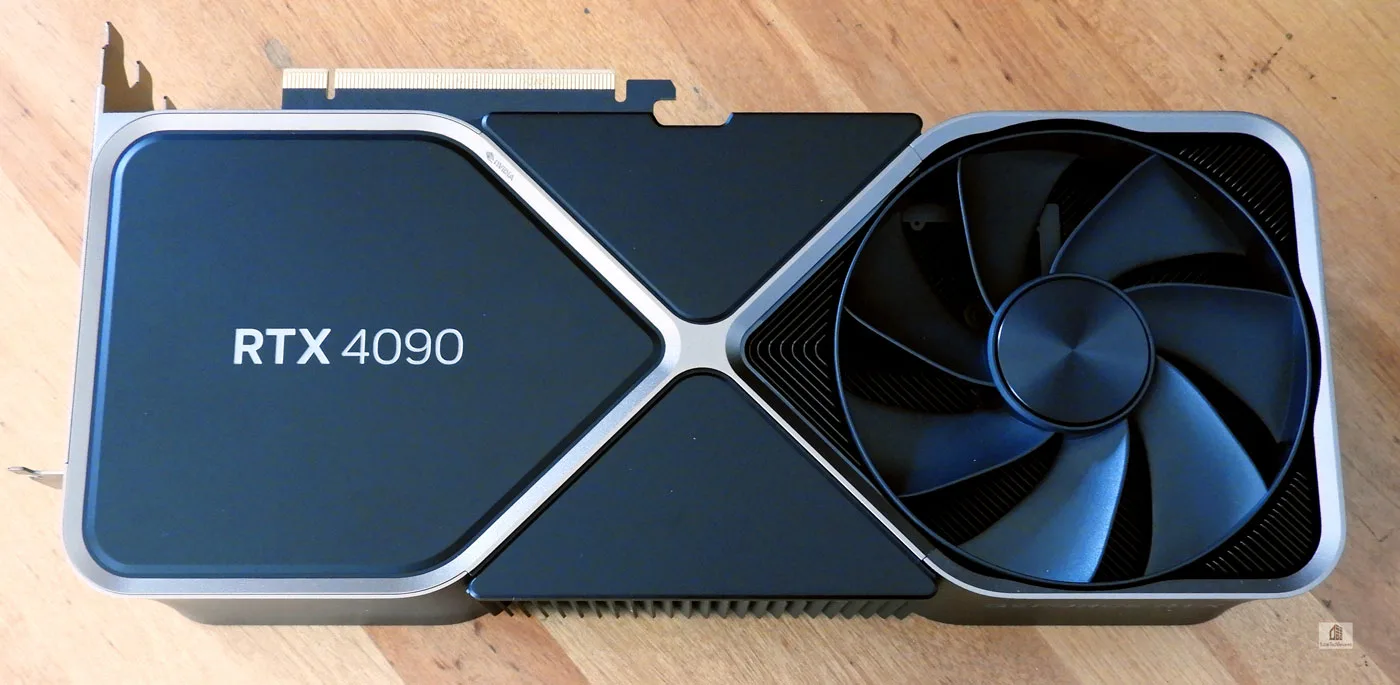
The RTX 4090 is touted as a beast in every way by Nvidia as the fastest video card for gaming with up to 4X the performance of the Ampere flagship or up to 2X the performance without using DLSS 3. The RTX 4090 boasts 83 Shader-TFLOPS, 191 RT-TFLOPS, and 1.3 Tensor petaFLOPS. It achieves over 1 TB/s memory bandwidth using 24 GB of GDDR6X memory. Its 72 MB L2 cache offers a 12X improvement over the RTX 3090 Ti.
We will focus on RTX 4090 raw performance as well as consider whether the new RTX 4090 Founders Edition at $1599 delivers a good value as a compelling upgrade from the RTX 3090 which launched at $1499 two years ago. We will also compare performance with the RX 6900 XT. In addition to gaming, VR, and SPECworkstation3 GPU results, we have added creative results using Geekbench, the Blender 3.3.0 benchmark, and complete Sandra 2020 and AIDA64 GPGPU benchmark results plus some pro applications including Blender rendering and OTOY OctaneRender.

We benchmark using Windows 11 Pro Edition 2H22 at 2560×1440 and at 3840×2160 using Intel’s Core i9-12900K and 32GB of T-FORCE DELTA RGB 6400MHz CL40 DDR5 2x16GB memory on an ASUS ROG Maximus Apex motherboard. All games and benchmarks are the latest versions, and we use the latest GeForce Game Ready press drivers for games and for testing pro apps, and Adrenalin 22.10.1 for the RX 6900 XT benching.
Let’s first take a quick look at the RTX 4090 Founders Edition before we go to the test configuration
The RTX 4090 Founders Edition Unboxing
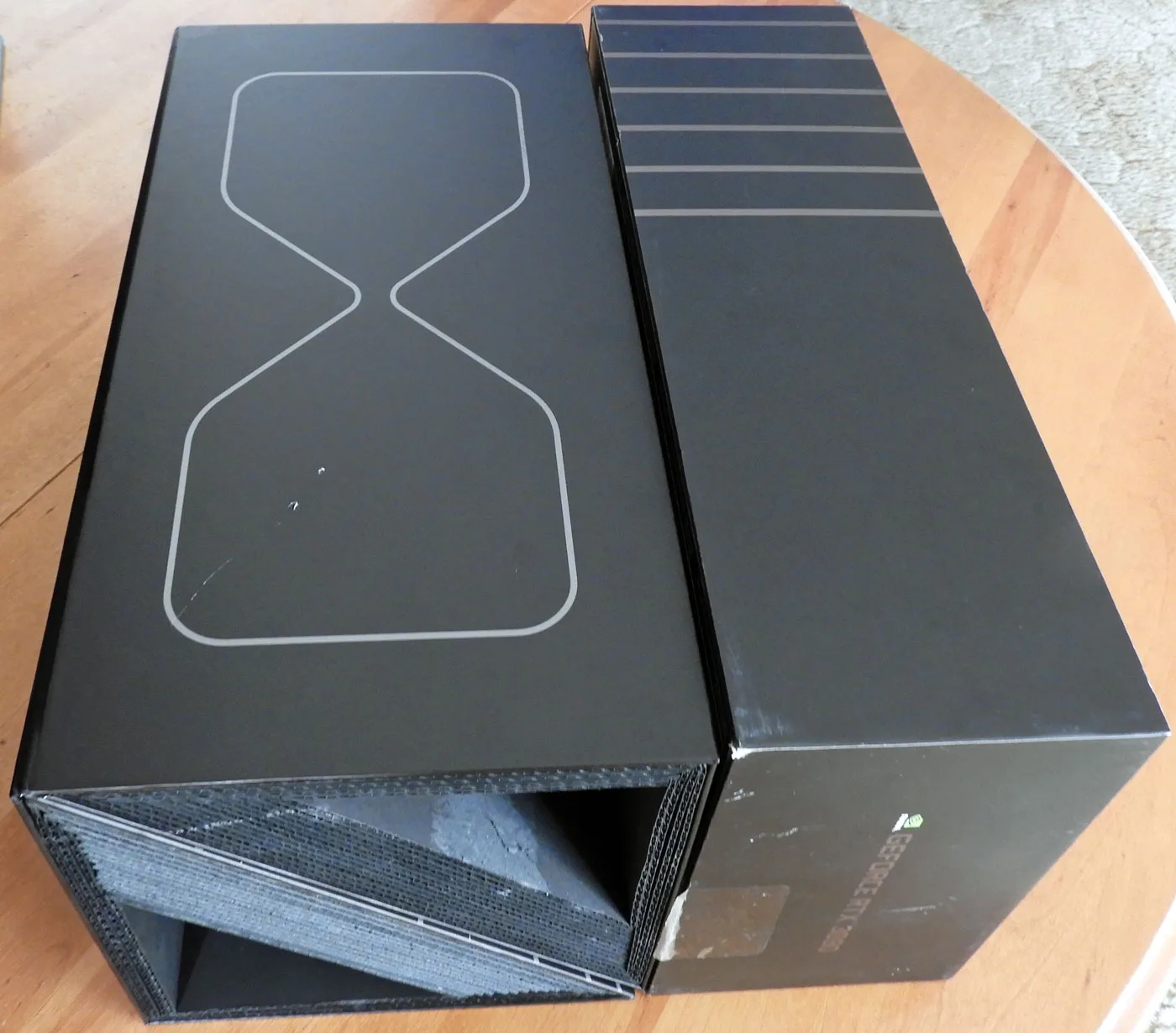
Just like as with all RTX 3000 Founders Edition cards, the RTX 4090 comes in a similar “shoebox” style where the card inside lays flat at an slight incline for display. However, the RTX 4090 box is much thicker and probably close to 50% larger.
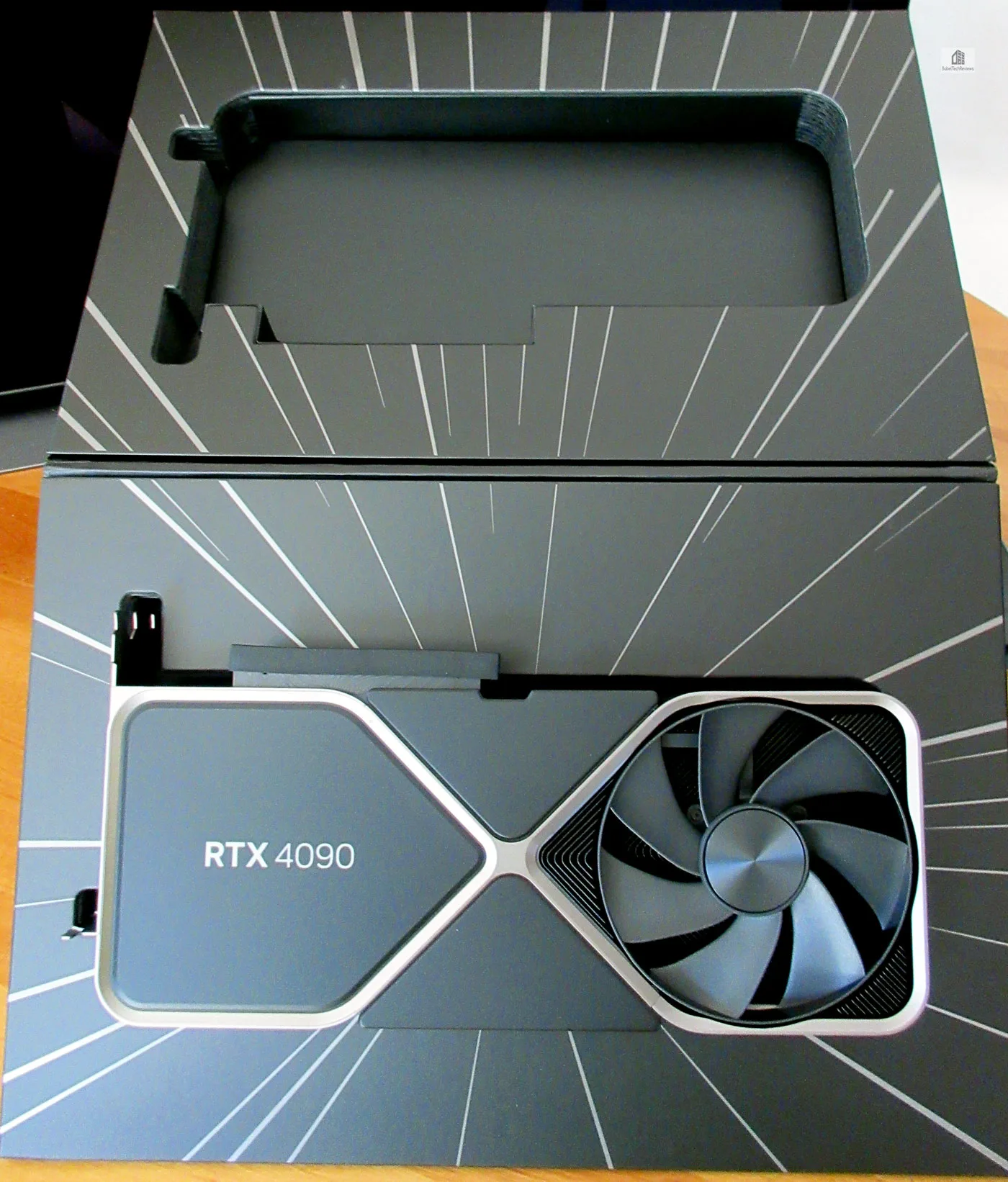
The system requirements, contents, and warranty information are printed on the bottom of each box. 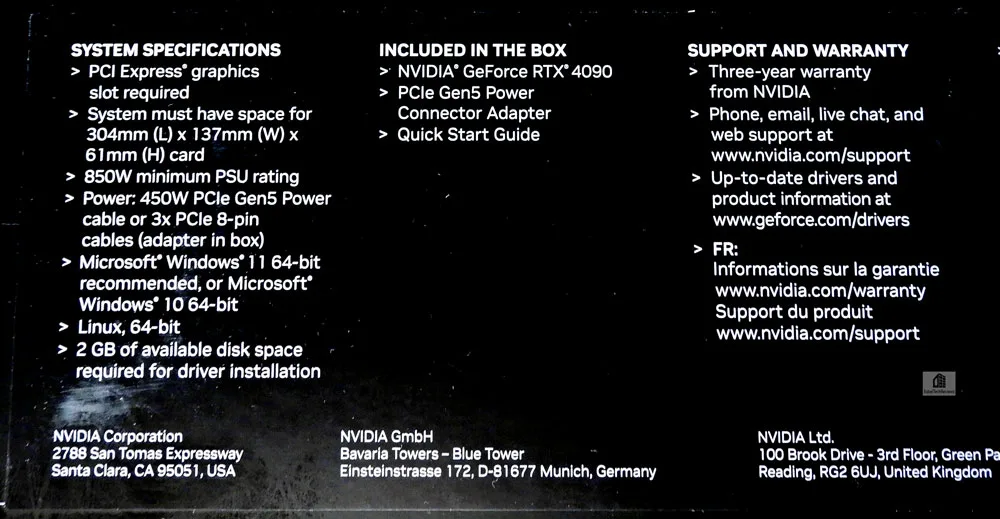 The RTX 4090 requires an 850W power supply unit – 100W more than the RTX 3090 – and the case must have space for a 304mm (L) x 137mm (W) x 61mm (H) three-slot card. However, it easily fits in our Corsair 5000D ATX mid-tower. The extra thick packing of the box protects the card. Inside the box and beneath the card are warnings, a quick start guide, and warranty information, plus the PCIe Gen5 power cable adapter to quad PCIe 8-pin cables that will be required to connect the RTX 4090 to most PSUs.
The RTX 4090 requires an 850W power supply unit – 100W more than the RTX 3090 – and the case must have space for a 304mm (L) x 137mm (W) x 61mm (H) three-slot card. However, it easily fits in our Corsair 5000D ATX mid-tower. The extra thick packing of the box protects the card. Inside the box and beneath the card are warnings, a quick start guide, and warranty information, plus the PCIe Gen5 power cable adapter to quad PCIe 8-pin cables that will be required to connect the RTX 4090 to most PSUs.

The RTX 4090 Founders Edition exudes a premium and solid feel from its industrial design. It is a very heavy 3-slot card and we use two thumbscrews to lock it down, taking care not to damage our PCIe slot.
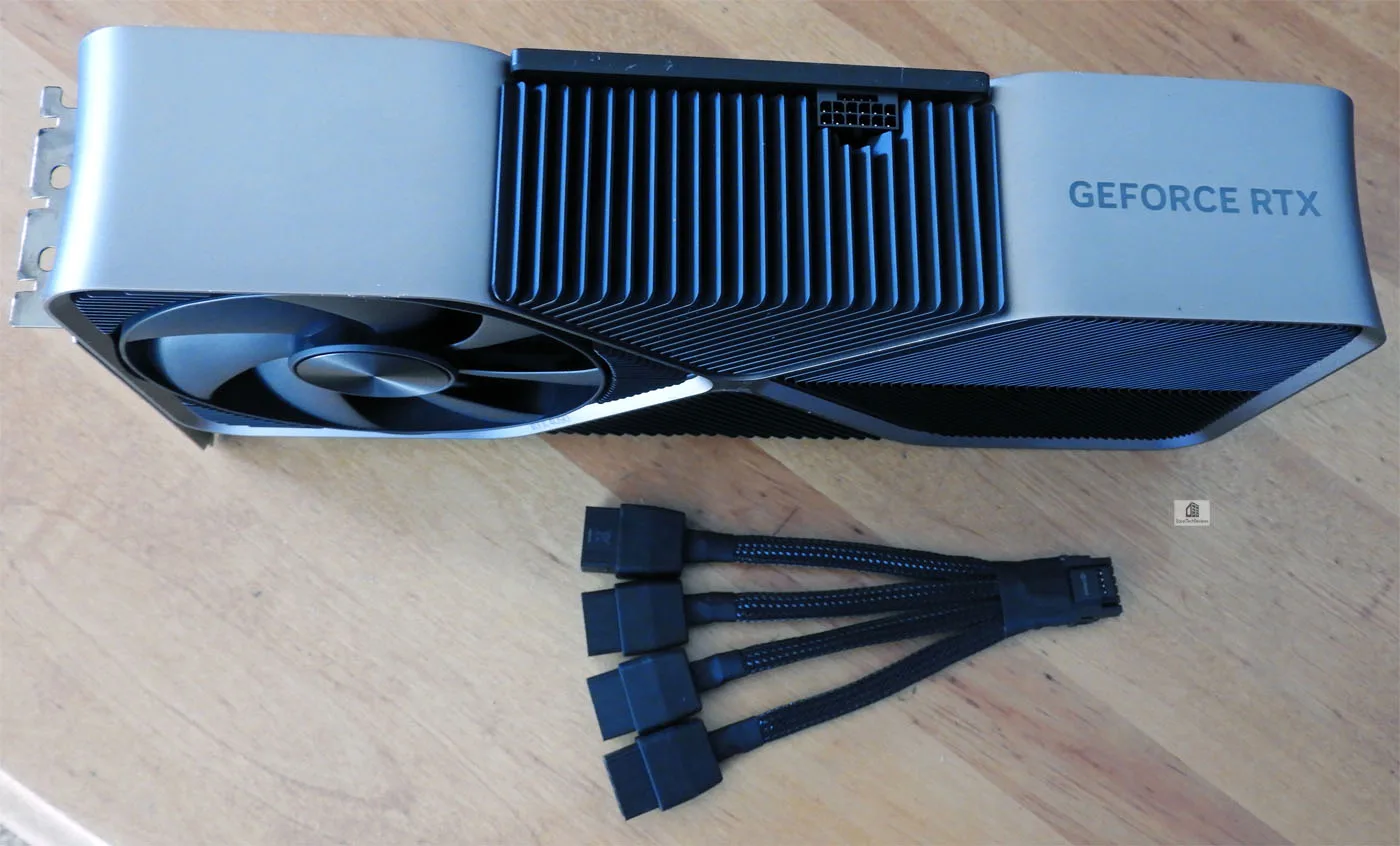
The power connector adapter requires three or four molex cables from the PSU to operate; the fourth cable is for overclocking. Newer PSUs may offer the new PCIe Gen5 single cable connector instead of a bulky quad cable.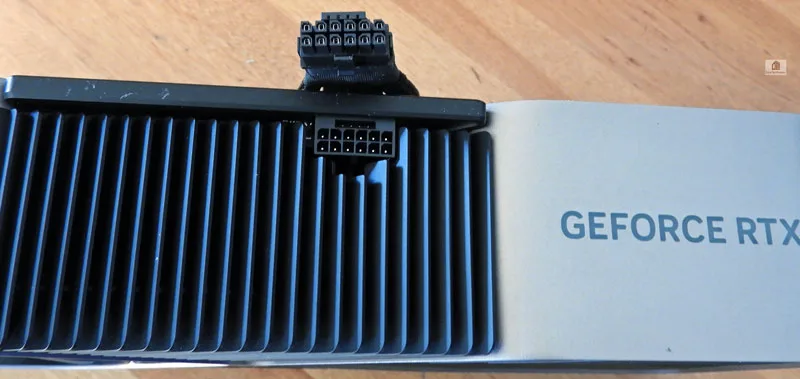
Turning the card over, we see a similar design of the Ada Lovelace FEs to the Ampere cards with a fan also on the other side.

The IO panel has a very large air vent and four connectors. The connectors are similar to the Founders Edition of the RTX 3090. Three DisplayPort 1.4 connectors are included, and the HDMI 2.1 connector allows for 4K/120Hz or 8K/60Hz over a single HDMI cable.
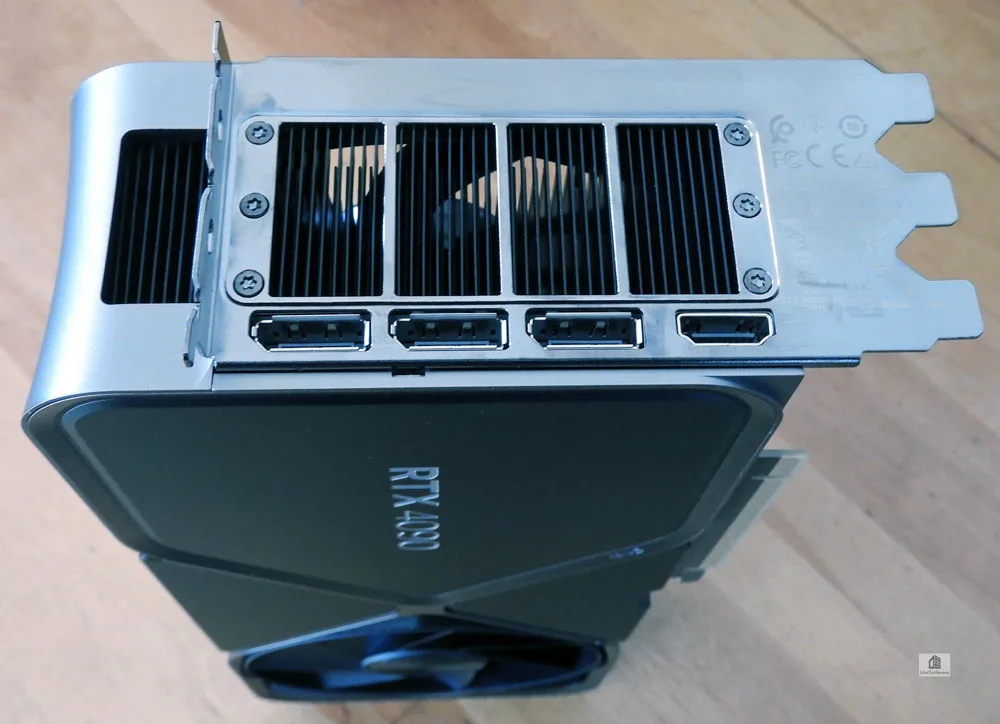
The other end offers a removable plate for enthusiasts to use a support bracket.
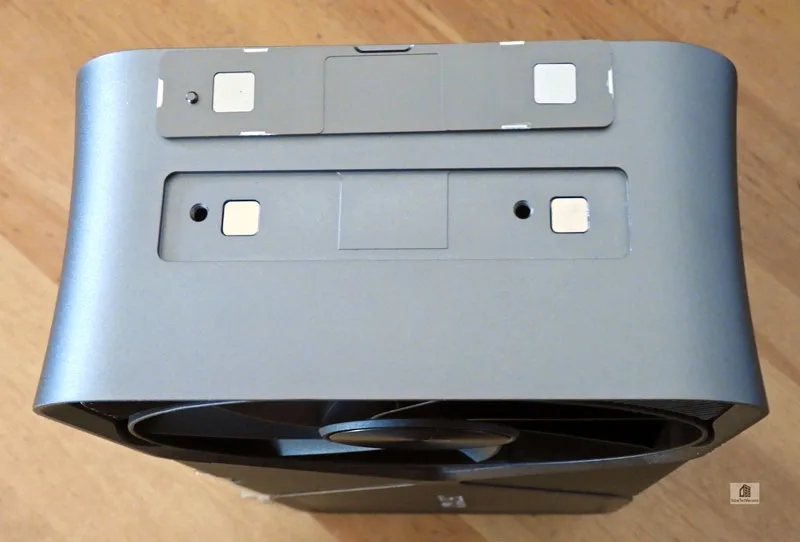
The RTX 4090 Founders Edition is a beautiful card with a very unique industrial style, and it’s larger than the RTX 3090 which is itself an imposing card. However, the larger Ada Lovelace card tends not to heat up like the RTX 3090 and it is also much quieter under full load. It looks great installed inside a case.
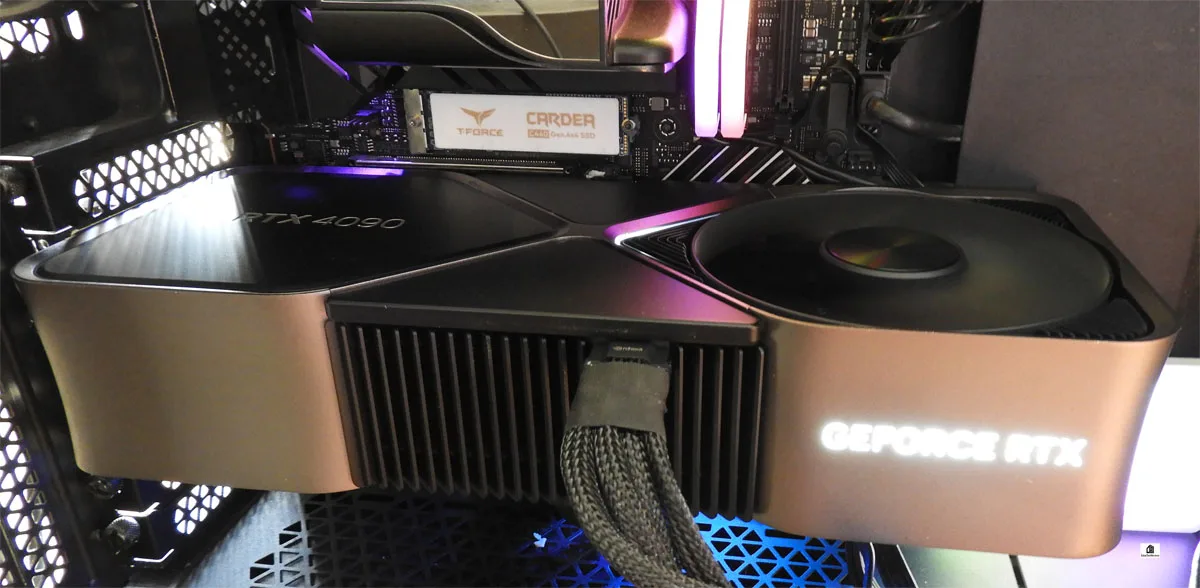
Disassembly appears to be very difficult and should give pause to any enthusiast who may have custom watercooling in mind. In fact, we think that watercooling is a waste for the Founders Edition as it doesn’t have any thermal issues.
Let’s check out our test configuration.
Test Configuration
Test Configuration – Hardware
- Intel Core i9-12900KF (HyperThreading and Turbo boost at stock settings)..
- ASUS ROG Maximus Z690 Apex LGA1700 motherboard (Intel Z690 chipset, latest BIOS, PCIe 5.0, DDR5)
- T-Force Delta RGB PC5-51200 6400MHz DDR5 CL40 2x16GB kit, supplied by TeamGroup
- Valve Index, 90Hz
- Gigabyte RX 6900 XT GAMING OC, GV-R69XTGAMING OC-16GD 16GB, factory clocks
- RTX 3090 24GB Founders Edition, factory clocks, supplied by Nvidia
- RTX 4090 24GB Founders Edition, stock clocks, supplied by Nvidia
- 2 x T-Force Cardea Ceramic C440; 2TB PCIe Gen 4 x4 NVMe SSD (one for AMD/one for Nvidia)
- T-Force M200 4TB USB 3.2 Gen2x2 Type-C Portable SSD, supplied by TeamGroup
- Super Flower LedEx, 1200W Platinum 80+ power supply unit
- MSI MAG Series CORELIQUID 360R (AIO) 360mm liquid CPU cooler
- Corsair 5000D ATX mid-tower (plus 1 x 140mm fan; 2 x 120mm Noctua fans)
- BenQ EW3270U 32? 4K HDR 60Hz FreeSync monitor
- LG C1 48″ 4K OLED HDR 120Hz display/TV
Test Configuration – Software
- GeForce press drivers for the RTX 3090 and RTX 4090, and Adrenalin 22.10.1 for the RX 6900 XT.
- High Quality, prefer maximum performance, single display, set in the Nvidia control panel.
- High Quality textures, all optimizations off in the Adrenalin control panel
- VSync is off in the control panel and disabled for each game
- AA enabled as noted in games; all in-game settings are Ultra Preset or highest with 16xAF always applied – no upscaling is used except for five DLSS games tested using the Quality preset.
- Highest quality sound (stereo) used in all games
- All games have been patched to their latest versions
- Gaming results show average frame rates in bold including minimum frame rates shown on the chart next to the averages in a smaller italics font where higher is better. The minimums are expressed by 1% lows (99th-percentile) in FPS
- Windows 11 Pro edition; 22H2 clean install for GeForce and Radeon cards on separate identical NVMe SSDs. DX11 titles are run under the DX11 render path. DX12 titles are run under DX12, and seven games use the Vulkan API.
- Latest DirectX
Games
Vulkan
- Sniper Elite
- DOOM Eternal
- Red Dead Redemption 2
- Ghost Recon: Breakpoint
- Wolfenstein Youngblood
- World War Z
- Strange Brigade
DX12
- Spiderman: Remastered
- F1 2022
- Ghostwire: Tokyo
- Elden Ring
- God of War
- Dying Light 2
- Forza Horizon 5
- Call of Duty: Vanguard
- Marvel’s Guardians of the Galaxy
- Far Cry 6
- DEATHLOOP
- Chernobylite
- Resident Evil Village
- Metro Exodus Enhanced Edition
- Hitman 3
- Godfall
- DiRT 5
- Assassin’s Creed Valhalla
- Cyberpunk 2077
- Watch Dogs: Legions
- Horizon Zero Dawn
- Death Stranding
- Borderlands 3
- Tom Clancy’s The Division 2
- Civilization VI – Gathering Storm Expansion
- Battlefield V
- Shadow of the Tomb Raider
DX11
- Overwatch 2
- Total War: Warhammer III
- Days Gone
- Crysis Remastered
- Destiny 2 Shadowkeep
- Total War: Three Kingdoms
- Grand Theft Auto V
VR Games
- Assetto Corsa: Competizione
- Elite Dangerous
- F1 2022
- No Man’s Sky
- ProjectCARS 2
Synthetic
- TimeSpy & Time Spy Extreme (DX12)
- 3DMark FireStrike – Ultra & Extreme
- Superposition
- VRMark Blue Room
- AIDA64 GPGPU benchmarks
- Blender 3.3.0 benchmark
- Geekbench
- Sandra 2020 GPGPU Benchmarks
- SPECworkstation3
- SPECviewperfect 2020
- Octanebench
- FrameView benching tool
- OCAT benching tool
NVIDIA Control Panel settings
Here are the NVIDIA Control Panel settings.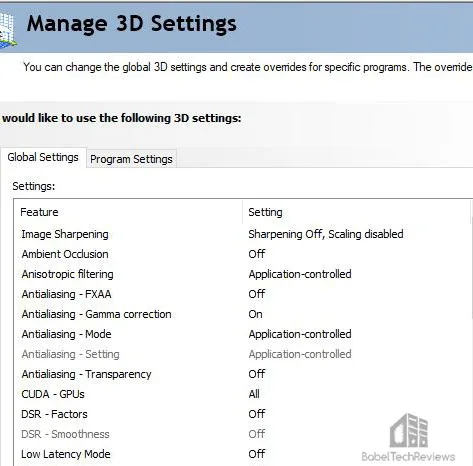
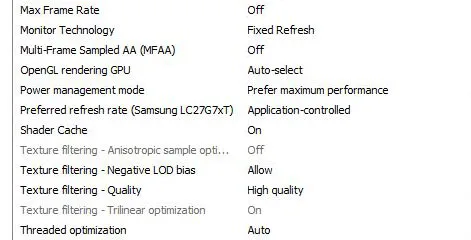

Unfortunately, we did not have time to check out overclocking, but temperatures and noise levels are lower than the RTX 3090 FE. We plan to follow this review up with a VR review, an overclocking review, and a DLSS 3 review.
Let’s check out performance using 41 pancake and 5 VR games plus Workstation and creative benches on the next page.
Performance summary charts & graphs
Main Performance Gaming Summary Charts
Here are the summary charts of 41 games and 6 synthetic tests. The highest settings are always chosen, ray tracing is enabled for all games that offer it, and the settings are listed on the chart. The benches were run at 2560×1440 and at 3840×2160 as it is pointless to test at 1920×1080 with such a powerful card. In fact, we see CPU bottlenecking at 1440P for certain games.
Three cards are compared and they are listed in order starting with the RTX 4090, the RX 6900 XT, and the RTX 3090. We do not have a RX 6950 XT or a RTX 3090 Ti and no other cards are in this class.
All results, except for synthetic scores, show average framerates, and higher is better. Minimum framerates are next to the averages in italics and in a slightly smaller font. Minimum framerates are expressed by the 99th-percentile (1% lows) and higher is better.


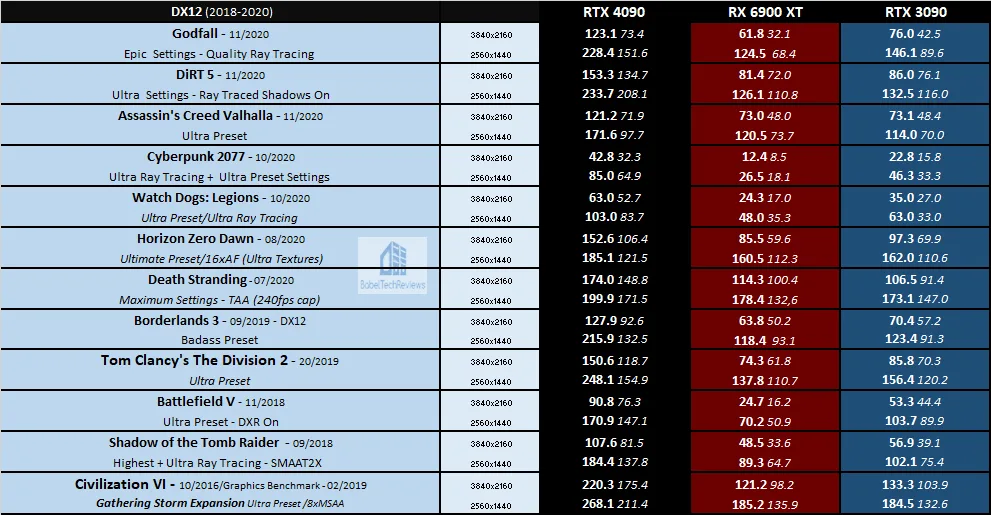


The RTX 4090 offers an overall 160% to 180% improvement over the RTX 3090’s baseline performance (at 100%) depending on the resolution and individual game, and in several examples it offers nearly a 200% improvement!
All of the games that we tested ran well on the RTX 4090. Although some games show less of a performance increase than others due to being CPU bound even at 1440P, it is a blowout and the RTX 4090 FE wins every game benchmark over the RTX 3090 and RX 6900 XT – it crushes the former Ampere and RDNA2 flagships. This is achieved with no upscaling whatsoever!
The RTX 4090 is the first single-GPU card that is truly suitable for 4K/60+ FPS using ultra/maxed-out ray traced settings for most modern demanding games without any upscaling, and it’s probably even solid for 4K/120 FPS using Quality DLSS which has equivalent or better visuals than the native image.
Next we look at five RTX/DLSS enabled games, each using maximum ray traced settings and the highest Quality DLSS.
RTX/DLSS Benchmarks
The RTX 4090 FE maintains its performance dominance over the RTX 3090 FE and pulls even further away when Quality DLSS is enabled.

Using Quality DLSS, we can see that the RTX 4090 will take advantage of an LG C1 4K/120Hz panel using the most demanding ray traced modern games. From testing DLSS 2 exhaustively, we note that the Quality setting at 4K is visually equal to or better than the native image.
We only had a little time to check out DLSS 3 which upscales far better than DLSS 2 and looks just as good. We believe that DLSS 3 will prove especially advantageous for the less powerful upcoming Ada Lovelace cards and will devote an upcoming review to it.
Next, we look at VR performance.
VR Games
For this review we benchmarked the Valve Index and set the SteamVR render resolution to 150% (2758×2740) which is considered ideal, if overkill, to compensate for lens distortion, and it’s well above our usual benchmarking render resolution at 100%. This higher render resolution gives the visuals exceptional clarity. The Index is still considered one of the best overall headsets due to its outstanding tracking and solid feature set, and we are going to compare the performance of the RX 4090 versus the RX 3090 at each game’s Ultra/Highest settings.
IMPORTANT: BTR’s charts use frametimes in ms where lower is better, but we also compare “unconstrained framerates” which shows what a video card could deliver (headroom) if it wasn’t locked to either 90 FPS or to 45 FPS by the HMD. In the case of unconstrained FPS, measuring just one important performance metric, faster is better.
Let’s individually look at our 5 sim-heavy VR games’ performance using FCAT VR. All of these games were benchmarked at 150% SteamVR resolution as we compare the stock-clocked RTX 4090 FE with the stock RTX 3090 FE using the Valve Index and FCAT VR.
First up, Assetto Corsa Competizione.
Assetto Corsa: Competizione (ACC)
BTR’s sim/racing editor, Sean Kaldahl created the replay benchmark run that we use for both the pancake game and the VR game. It is run at night with 20 cars, lots of geometry, and the lighting effects of the headlights, tail lights, and everything around the track looks spectacular.
VR Ultra
Here are the ACC FCAT VR frametimes using VR Ultra.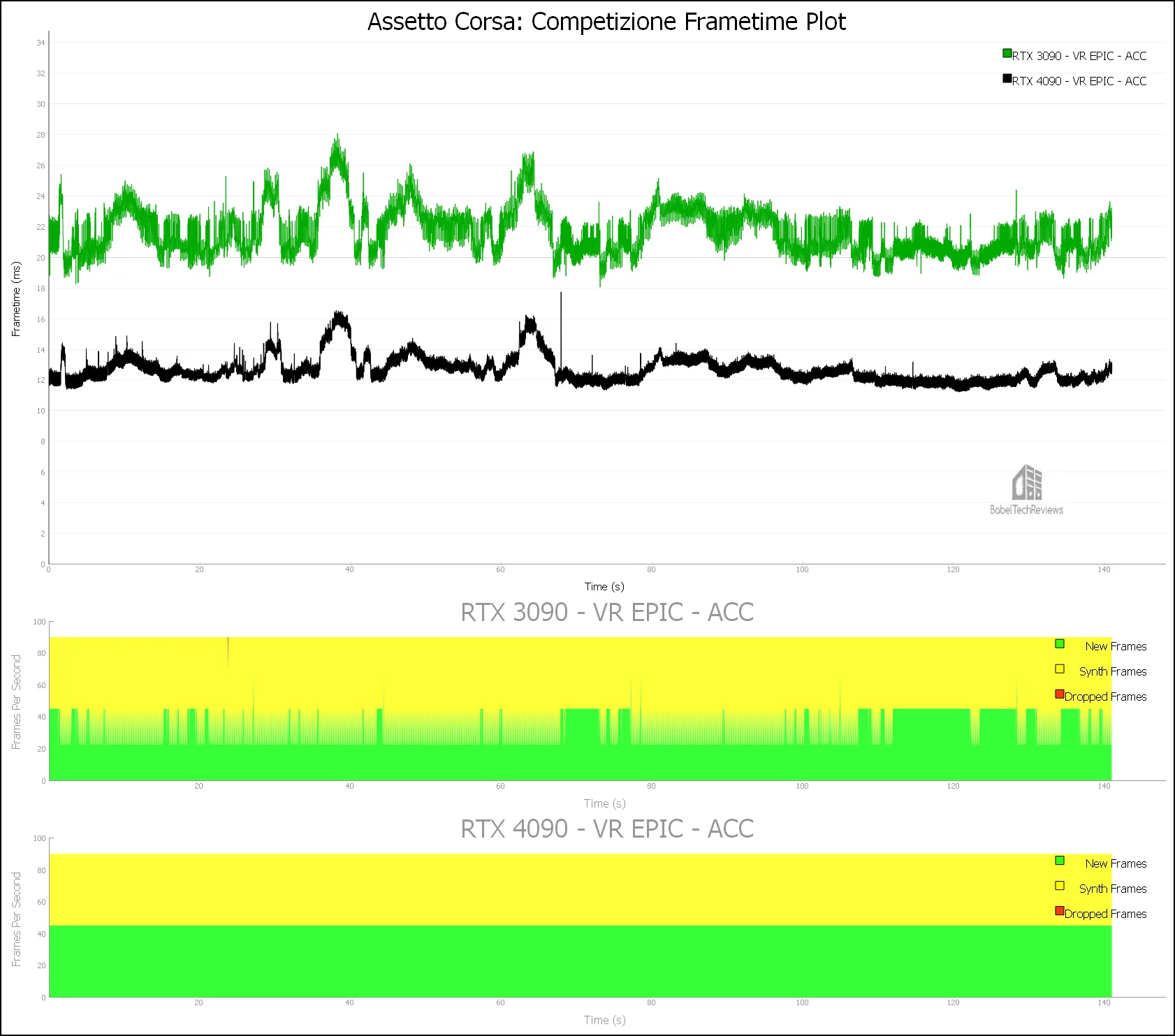
Here are the details are reported by FCAT-VR:
The RTX 3090 delivered 46.26 unconstrained FPS with 7884 (62%) synthesized frames with 1 dropped frame and 1 Warp miss.
The RTX 4090 delivered 78.63 unconstrained FPS together with 6346 (50%) synthetic frames but with no dropped frames nor Warp misses.
The ACC racing experience is better with the RTX 4090. However, the only way that the RTX 4090 can play on VR Epic is to lower the SteamVR render resolution to 100% as it is best to have no synthesized frames.
Next, we check out Elite Dangerous next.
Elite Dangerous (ED)
Elite Dangerous is a popular space sim built using the COBRA engine. It is hard to find a repeatable benchmark outside of the training missions.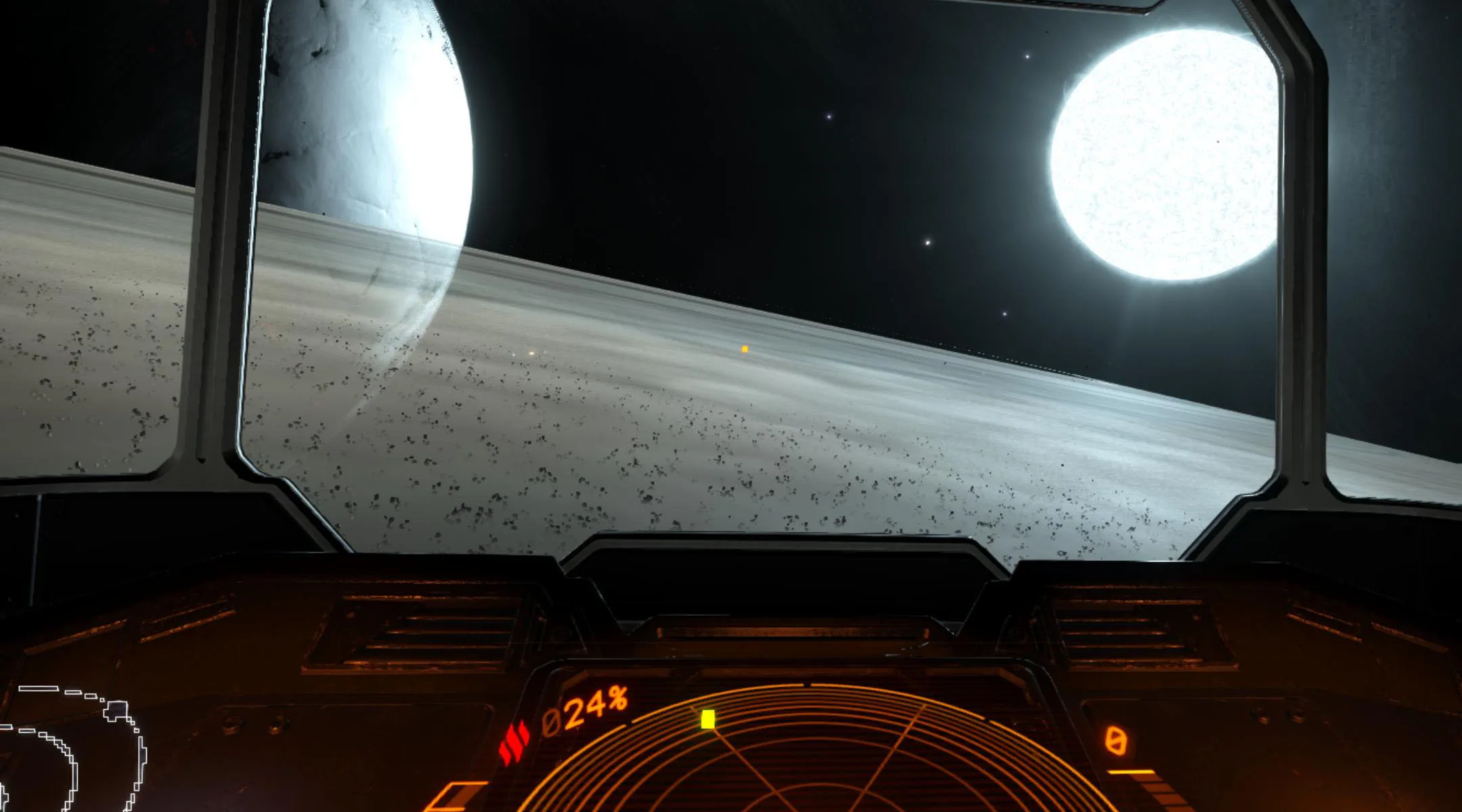
A player will probably spend a lot of time piloting his space cruiser while completing a multitude of tasks as well as visiting space stations and orbiting a multitude of different planets. Elite Dangerous is also co-op and multiplayer with a dedicated following of players.
We picked the Ultra Preset and we set the Field of View to its maximum. Here are the frametimes.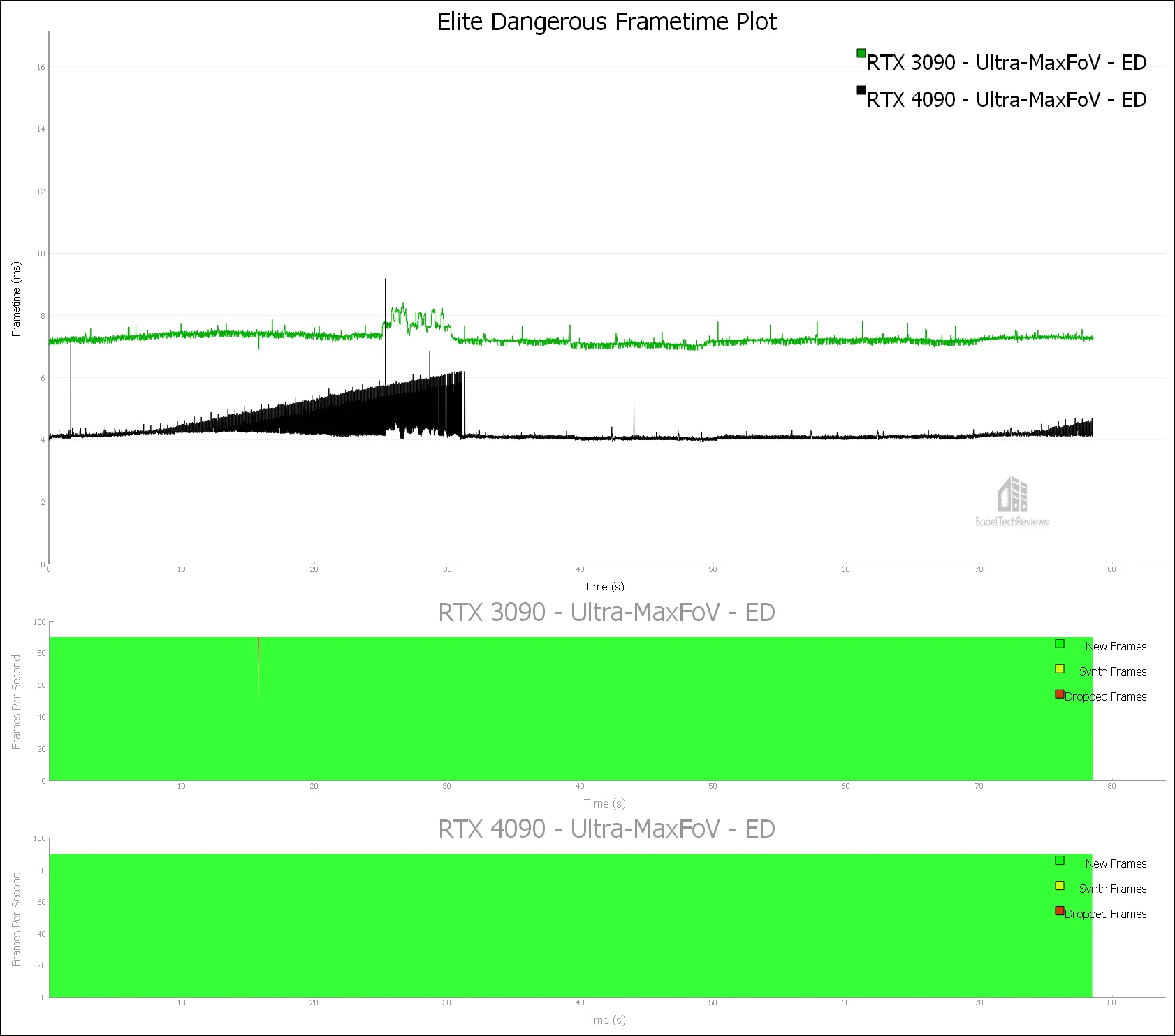
Here are the details as reported by FCAT-VR:
The RTX 3090 delivered 137.33 unconstrained FPS with 1 synthesized frames with 1 dropped frame and 1 Warp miss.
The RTX 4090 delivered 236.17 unconstrained FPS together with no synthetic frames and with no dropped frames nor Warp misses.
The experience playing Elite Dangerous at Ultra settings is not perceptibly different on either video card but the RTX 4090 has a lot more performance headroom to increase the render resolution or to use a higher resolution headset like the Reverb G2 or the Vive Pro 2.
Let’s look at our newest VR sim, F1 2022.
F1 2022
Codemasters has captured the entire Formula 1 2021 season racing in F1 2022, and the VR immersion is good. The graphics are customizeable and solid, handling and physics are good, the AI is acceptable, the scenery is outstanding, and the experience ticks many of the necessary boxes for a racing sim.
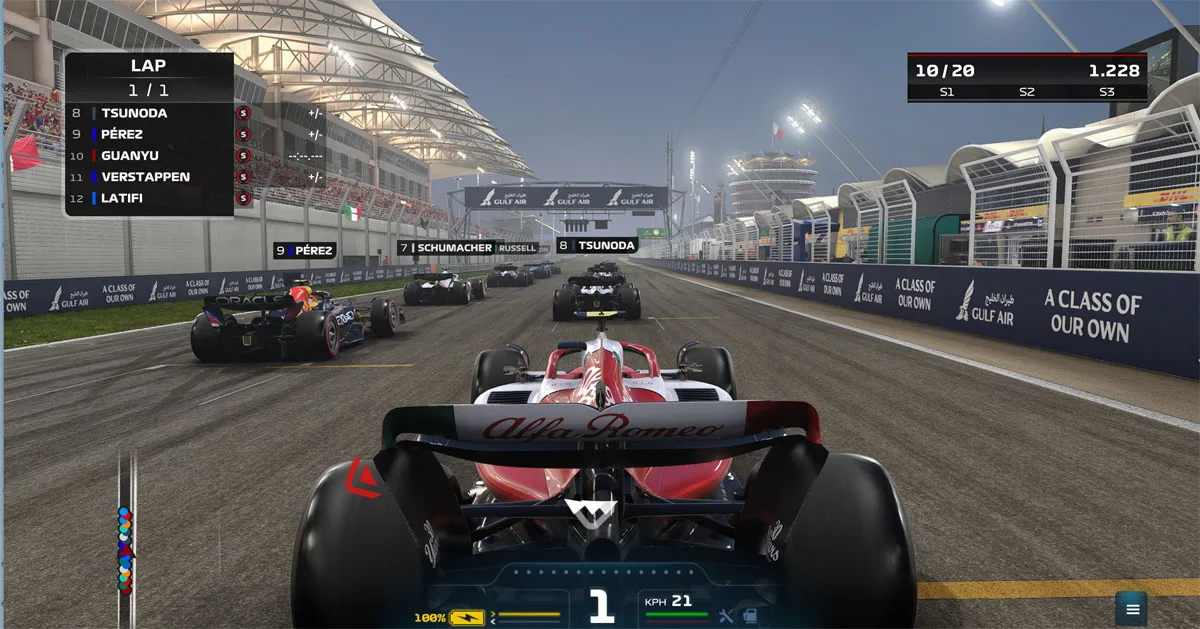
Here is the frametime plot for F1 2022.

Here are the details as reported by FCAT-VR.

The RTX 3090 delivered 117.16 unconstrained FPS with 2 synthesized frames but no dropped frames or Warp misses.
The RTX 4090 delivered 192.66 unconstrained FPS together with no synthetic frames and with no dropped frames nor Warp misses.
The experience playing F1 2022 using the Ultra preset is not very different on either video card but the RTX 4090 has more performance headroom to increase the framerate to 120Hz or to use a higher resolution headset.
Next we check out No Man’s Sky.
No Man’s Sky (NMS)
No Man’s Sky is an action-adventure survival single and multiplayer game that emphasizes survival, exploration, fighting, and trading. It is set in a procedurally generated deterministic open universe, which includes over 18 quintillion unique planets using its own custom game engine.
The player takes the role of a Traveller in an uncharted universe by starting on a random planet with a damaged spacecraft equipped with only a jetpack-equipped exosuit and a versatile multi-tool that can also be used for defense. The player is encouraged to find resources to repair his spacecraft allowing for intra- and inter-planetary travel, and to interact with other players.
Here is the No Man’s Sky Frametime plot. We set the settings to Maximum which is a step over Ultra including setting the anisotropic filtering to 16X and upgrading to FXAA+TAA. Since DLSS is available for RTX cards and the Quality setting improves performance without impacting image quality, we used it.
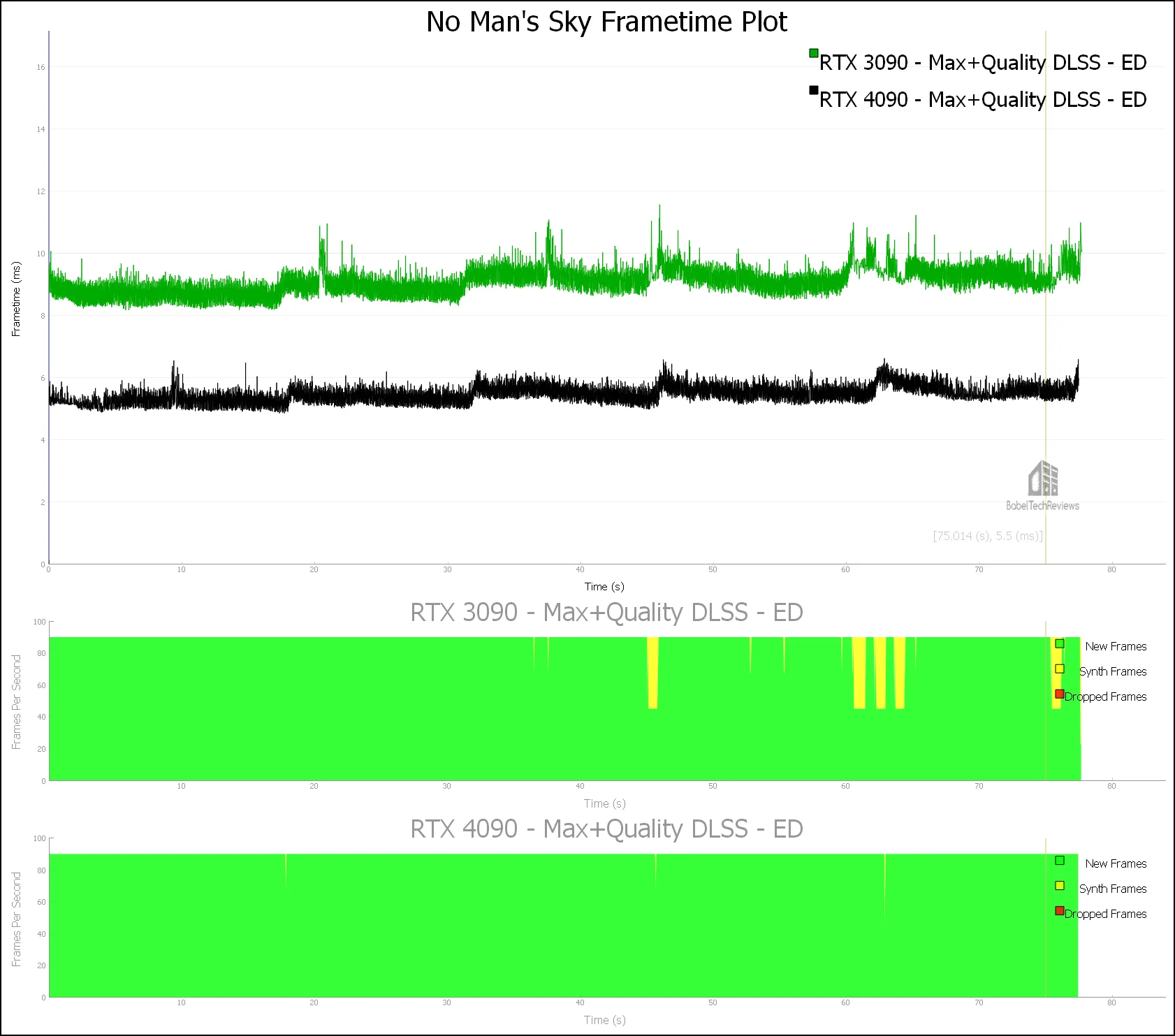
Here are the FCAT-VR details of our comparative runs.

The RTX 3090 delivered 109.88 unconstrained FPS with 198 (3%) synthesized frames but no dropped frames or Warp misses.
The RTX 4090 delivered 183.68 unconstrained FPS together with 4 synthetic frames and with no dropped frames nor Warp misses.
The experience playing No Man’s Sky using the highest settings is not very different on either video card but the RTX 4090 has far more performance headroom.
Let’s continue with another VR game, ProjectCARS 2, that we still like better than its successor even though it is no longer available for online play.
Project CARS 2 (PC2)
There is a real sense of immersion that comes from playing Project CARS 2 in VR using a wheel and pedals. It uses its in-house Madness engine, and the physics implementation is outstanding. We are disappointed with Project CARS 3, and will continue to use the older game instead for VR benching.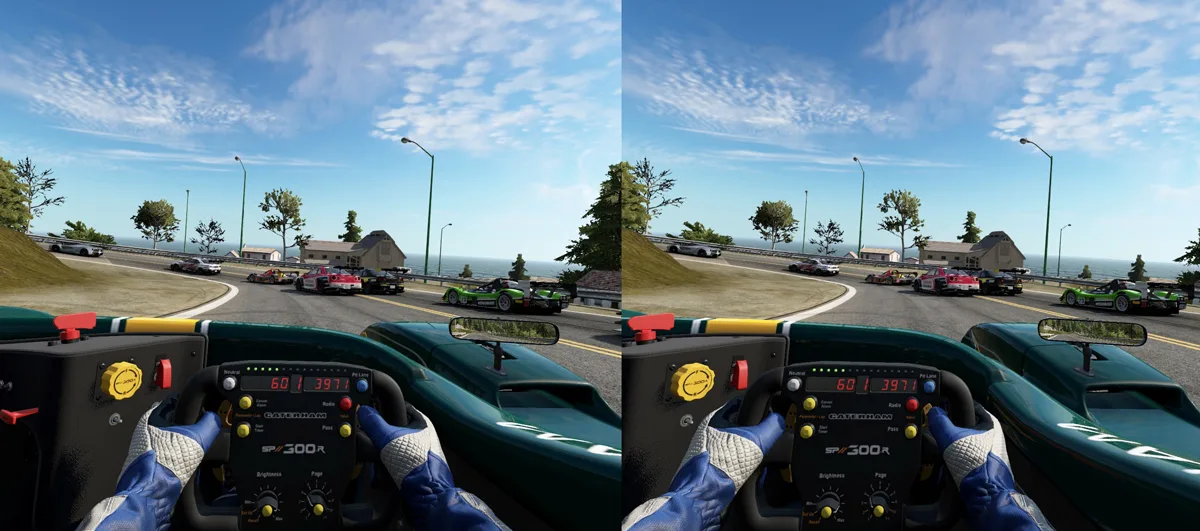
Project CARS 2 offers many performance options and settings and we prefer playing with SMAA Ultra rather than to use MSAA.
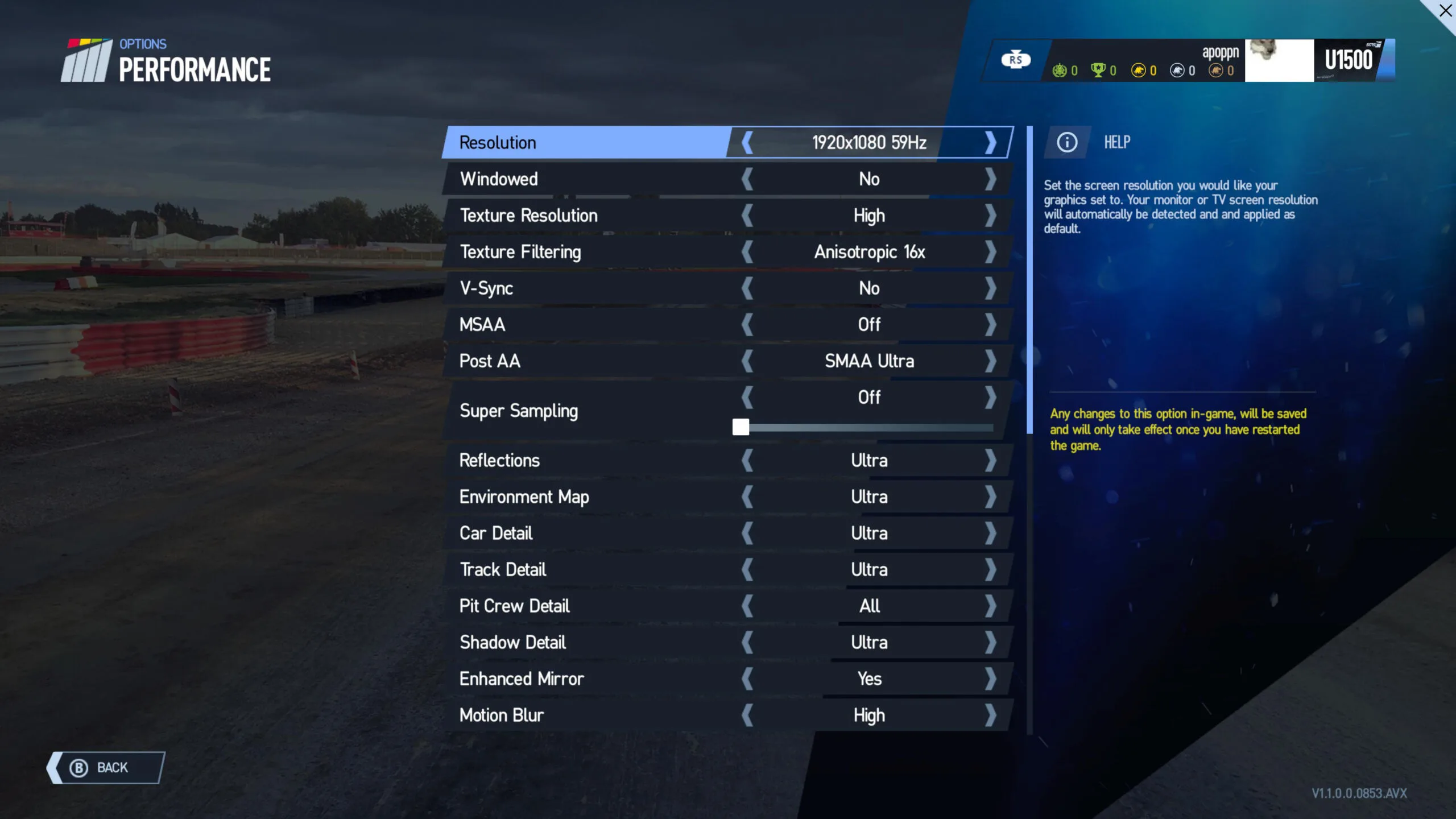
We used maximum settings including for Motion Blur.
Here is the frametime plot.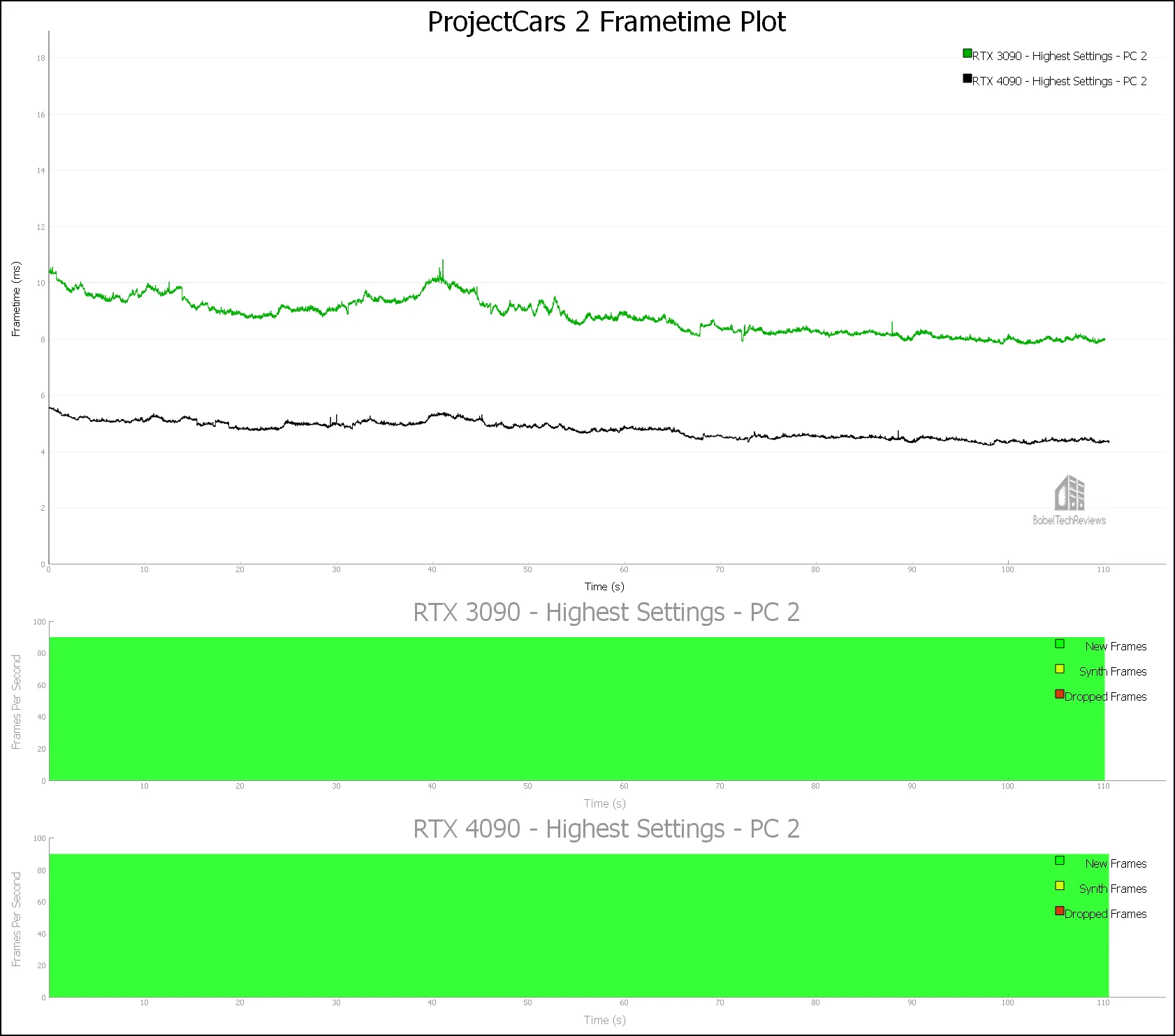
Here are the FCAT-VR details.
The RTX 3090 delivered 113.60 unconstrained FPS with no synthesized frames and no dropped frames or Warp misses.
The RTX 4090 delivered 209.53 unconstrained FPS together with no synthetic frames and with no dropped frames nor Warp misses.
The experience playing Project CARS 2 using maximum settings is similar for both video cards but the RTX 4090 has far more performance headroom to increase the framerate to 120Hz or to use a higher resolution headset like the Vive Pro 2 or Reverb G2.
Amazing. Although all of these maxed out VR benchmarks were run at SteamVR’s 150% render resolution (2758×2740), the RTRX 4090 only broke a sweat playing ACC.
Unconstrained Framerates
The following chart summarizes the overall Unconstrained Framerates (the performance headroom) of our two cards using our 5 VR test games. The preset is listed on the chart and higher is better.
 The RX 4090 FE delivers far higher unconstrained frames for all VR benchmarks over the RTX 3090 FE in this important performance metric. However, unconstrained framerates are just one metric that has to be taken together with the frametime plots to have any meaning. It is clear that the RTX 4090 is ready for higher resolution headsets than the Valve Index. We’ll follow up this review with an expanded VR review using the Reverb G2 and Vive Pro.
The RX 4090 FE delivers far higher unconstrained frames for all VR benchmarks over the RTX 3090 FE in this important performance metric. However, unconstrained framerates are just one metric that has to be taken together with the frametime plots to have any meaning. It is clear that the RTX 4090 is ready for higher resolution headsets than the Valve Index. We’ll follow up this review with an expanded VR review using the Reverb G2 and Vive Pro.
Creative, Pro & Workstation Apps
Let’s look at Creative applications next to see if the RTX 4090 is a good upgrade from the RTX 3090 or RX 6900 XT. We test starting with Geekbench.
GeekBench
GeekBench is an excellent CPU/GPU benchmarking program which runs a series of tests and times how long a GPU (in this case) takes to complete its tasks. It benchmarks OpenCL, Vulcan, and CUDA performance
OpenCL, Vulcan, and CUDA Performance
RTX 6900 XT
First, OpenCL performance.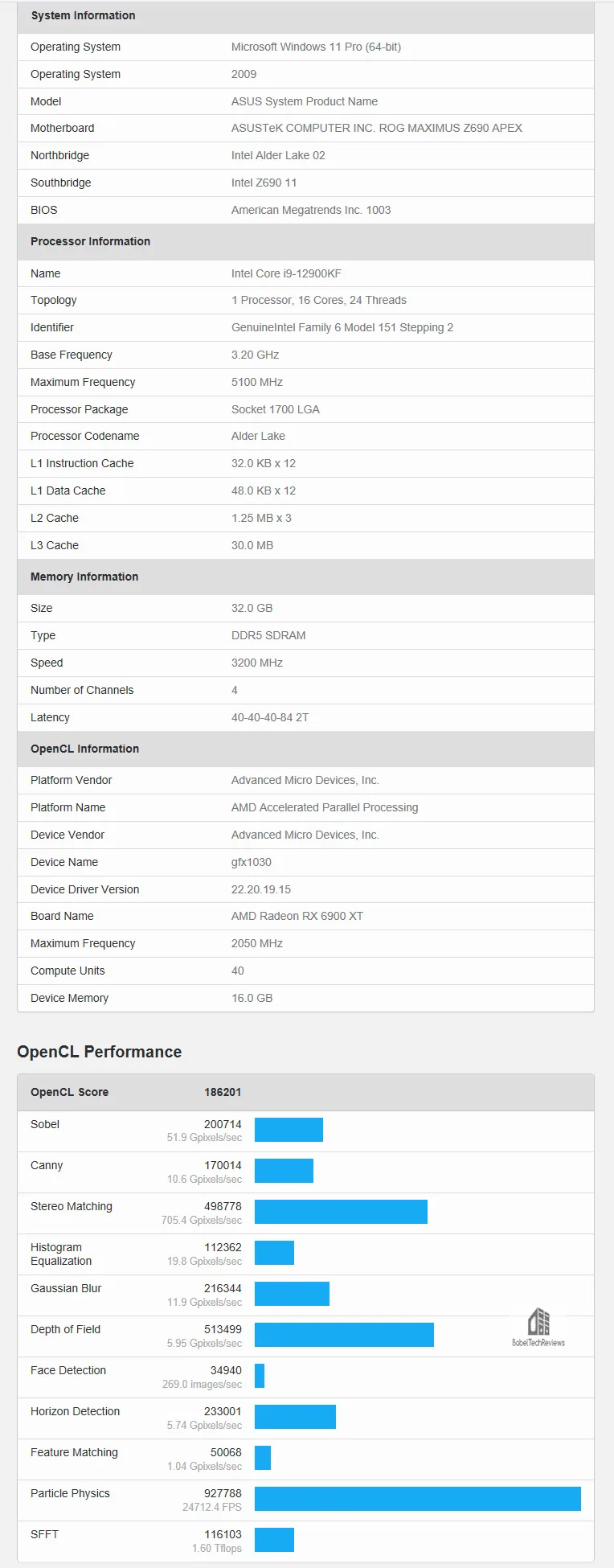
Next we test the RTX 6900 XT using Vulcan.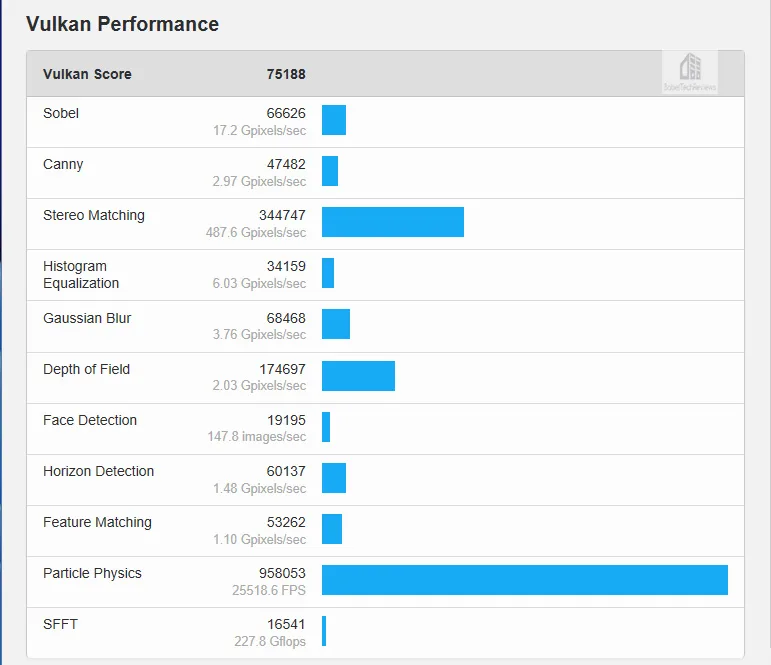
The 6900 XT does not run CUDA, so we move on to RTX 3090 performance.
RX 3090
First, OpenCL performance.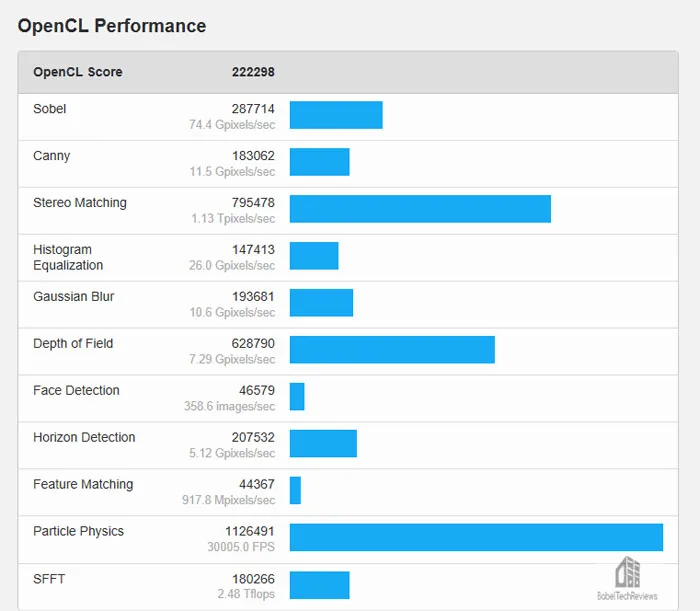
Next we test the RX 3090 using Vulcan.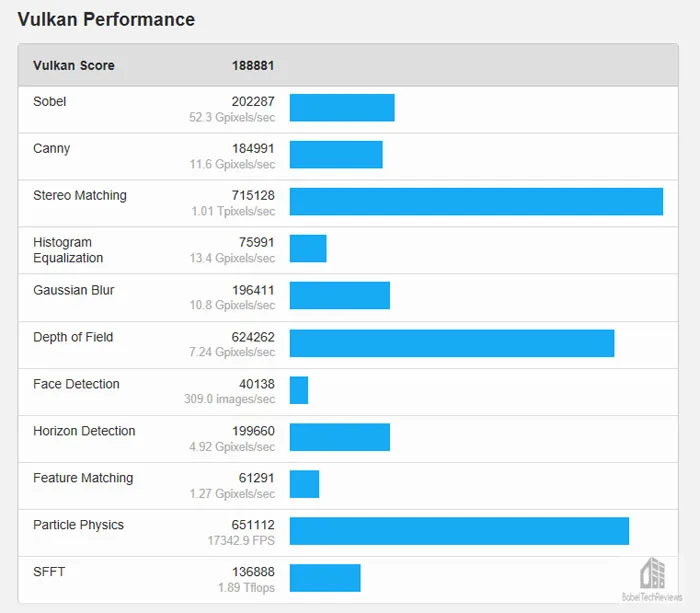
Finally, RTX 3090 CUDA performance.
We move on to RTX 4090 performance
RX 4090
First, OpenCL performance.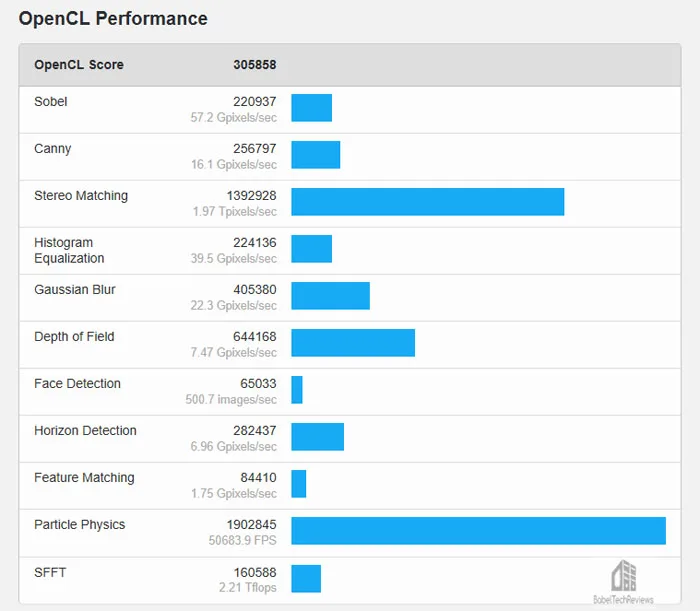
Next we test the RX 4090 using Vulcan.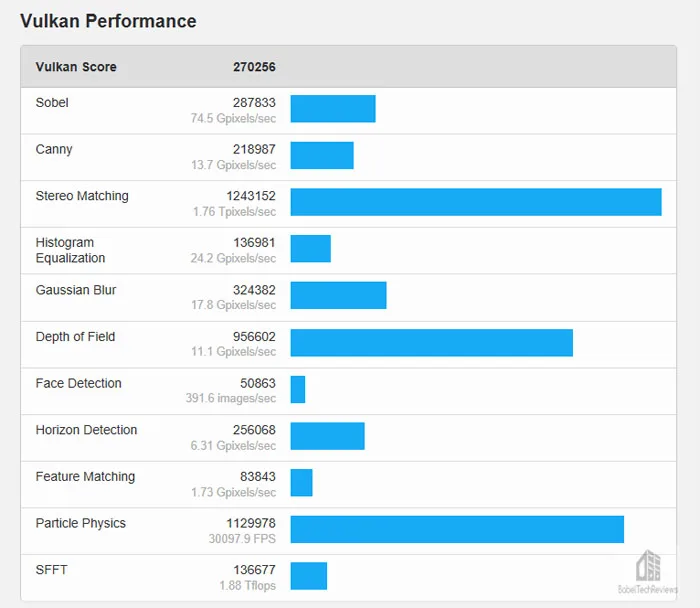
Finally, RTX 4090 CUDA performance.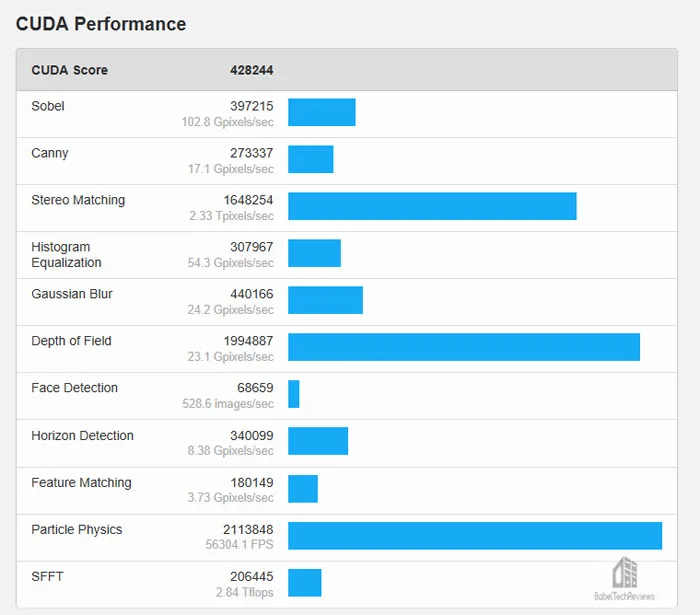
The summary charts below show the comparative performance scores.

Again, the RTX 4090 performance is outstanding.
Next up, Blender benchmark.
Blender 3.3.0 Benchmark
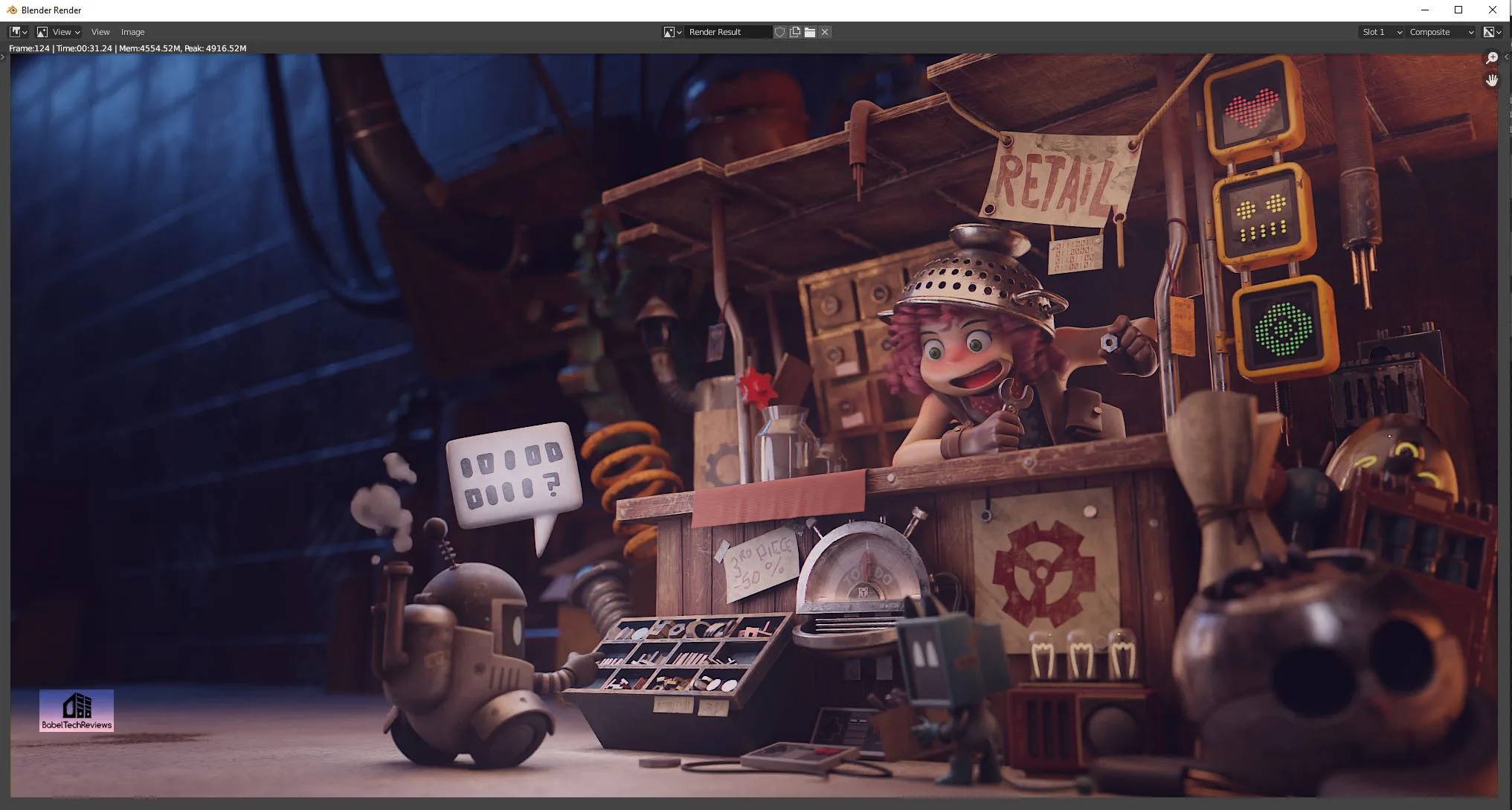
Blender is a very popular open source 3D content creation suite. It supports every aspect of 3D development with a complete range of tools for professional 3D creation.
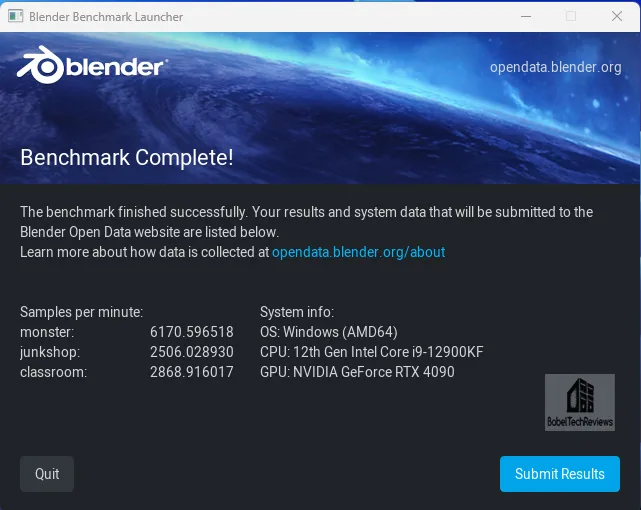
For the following chart, higher is better as the benchmark renders a scene multiple times and gives the results in samples per minute.

Blender’s benchmark performance is highest using the RTX4090, and often the amount of time saved is substantial over using the next fastest card, the RTX 3090.
Next, we look at the OctaneBench.
OTOY Octane Bench
OctaneBench allows you to benchmark your GPU using OctaneRender. The hardware and software requirements to run OctaneBench are the same as for OctaneRender Standalone.
We run OctaneBenc 2020.1.5 for Windows and here are the RTX 3090’s complete results and overall score of 671.17
We compare the score and results for the RTX 4090 – almost double the RTX 3090 score with 1261.64
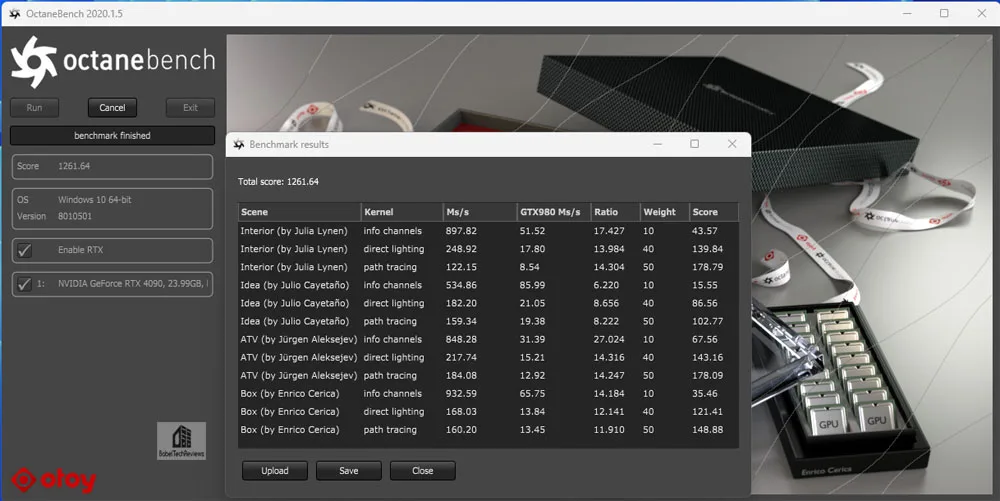 Here is the summary chart comparing the RTX 4090 with the RTX 3090 overall scores.
Here is the summary chart comparing the RTX 4090 with the RTX 3090 overall scores.

The RTX 4090 is a beast of a card when used for rendering.
Next, we move on to AIDA64 GPGPU benchmarks.
AIDA64
AIDA64 is an important industry tool for benchmarkers. Its GPGPU benchmarks measure performance and give scores to compare against other popular video cards.
AIDA64’s benchmark code methods are written in Assembly language, and they are well-optimized for every popular AMD, Intel, NVIDIA and VIA processor by utilizing the appropriate instruction set extensions. We use the Engineer’s full version of AIDA64 courtesy of FinalWire. AIDA64 is free to to try and use for 30 days. CPU results are also shown for comparison with the RTX 4090 GPGPU benchmarks.

Here is the chart summary of the AIDA64 GPGPU benchmarks with the RTX 4090, the RTX 3090 and the RX 6900 XT side-by-side.
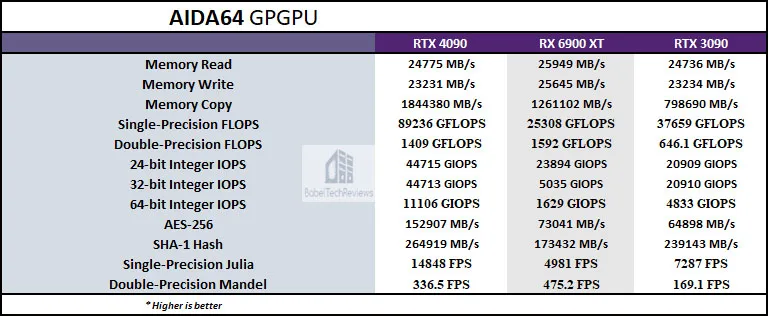
Generally the RTX 3090 is faster at almost all of AIDA64’s GPGPU benchmarks than the other cards. So let’s look at Sandra 2020 next.
SiSoft Sandra 2020
To see where the CPU, GPU, and motherboard performance results differ, there is no better tool than SiSoft’s Sandra 2020. SiSoftware SANDRA (the System ANalyser, Diagnostic and Reporting Assistant) is a excellent information & diagnostic utility in a complete package. It is able to provide all the information about your hardware, software, and other devices for diagnosis and for benchmarking. Sandra is derived from a Greek name that implies “defender” or “helper”.
There are several versions of Sandra, including a free version of Sandra Lite that anyone can download and use. 20/21-R16a is the latest version, and we are using the full engineer suite courtesy of SiSoft. Sandra 2020 features continuous multiple monthly incremental improvements over earlier versions of Sandra. It will benchmark and analyze all of the important PC subsystems and even rank your PC while giving recommendations for improvement.
With the above in mind, we ran Sandra’s intensive GPGPU benchmarks and charted the results summarizing them. The performance results of the RTX 4090 are compared with the performance results of the RTX 3080, and the RX 6900 XT.

In Sandra GPGPU benchmarks, the RTX 4090 is much faster than the RTX 3090 and it distinguishes itself in every area – Processing, Cryptography, Financial and Scientific Analysis, Image Processing, and Bandwidth.
Next up, SPEC benchmarks.
SPECworkstation3.1 Benchmarks
All the SPECworkstation 3 benchmarks are based on professional applications, most of which are in the CAD/CAM or media and entertainment fields. All of these benchmarks are free except for vendors of computer-related products and/or services.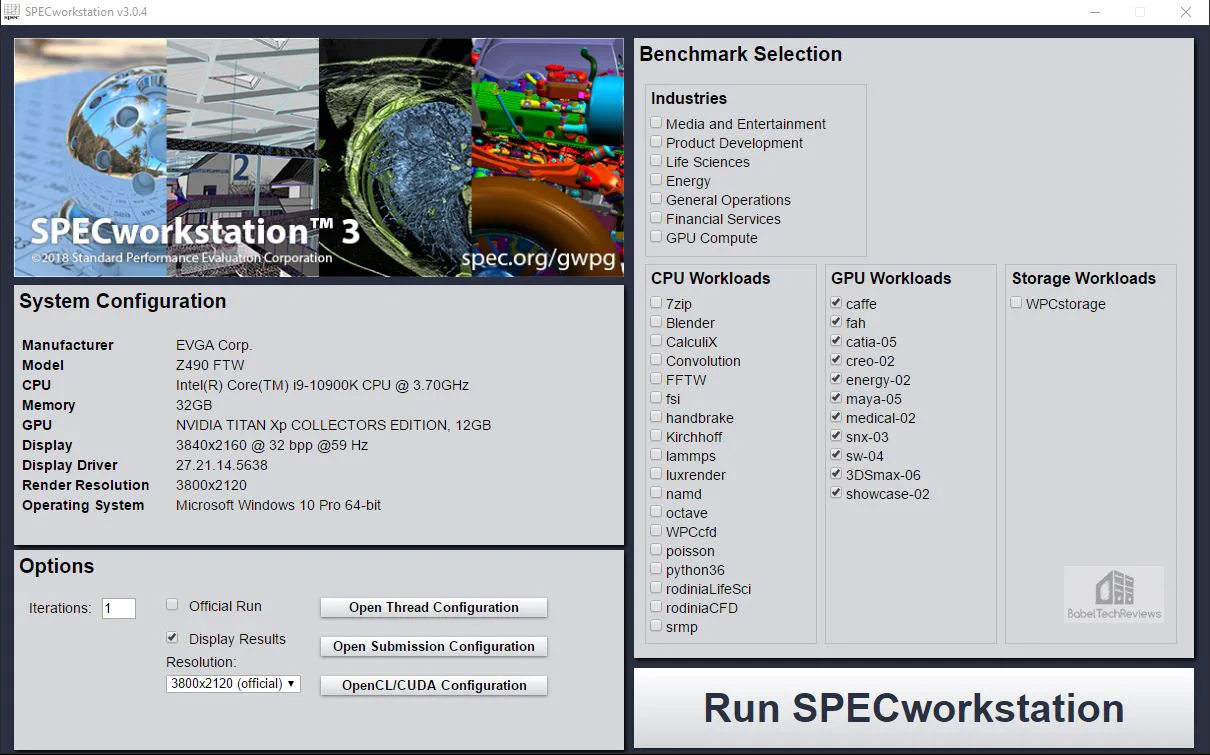
The most comprehensive workstation benchmark is SPECworkstation 3. It’s a free-standing benchmark which does not require ancillary software. It measures GPU, CPU, storage and all other major aspects of workstation performance based on actual applications and representative workloads. We only tested the GPU-related workstation performance as checked in the image above.
Here are our raw SPECworkstation 3.1 raw scores for the RX 6900 XT: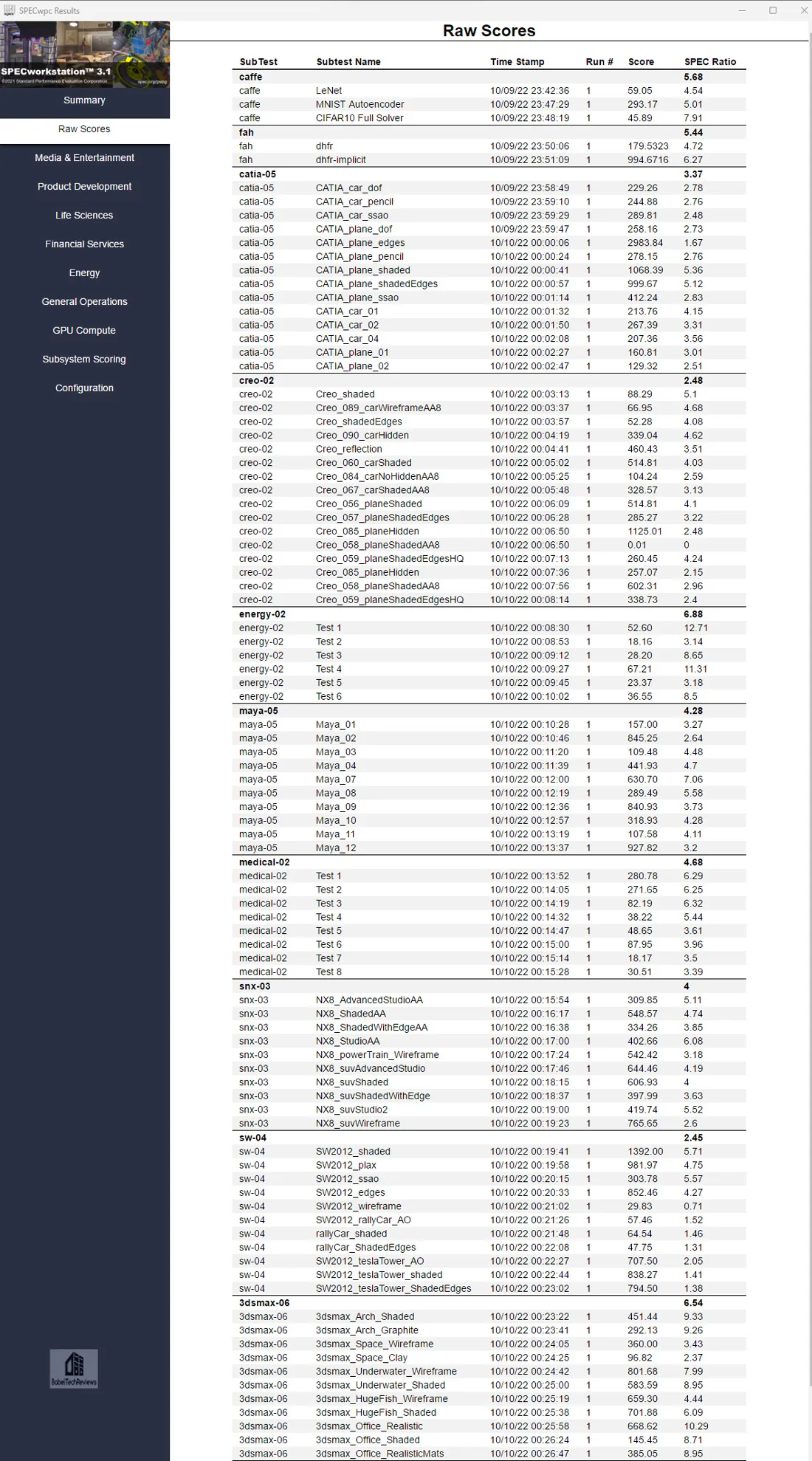

Here are our raw SPECworkstation 3.1 raw scores for the RTX 3090: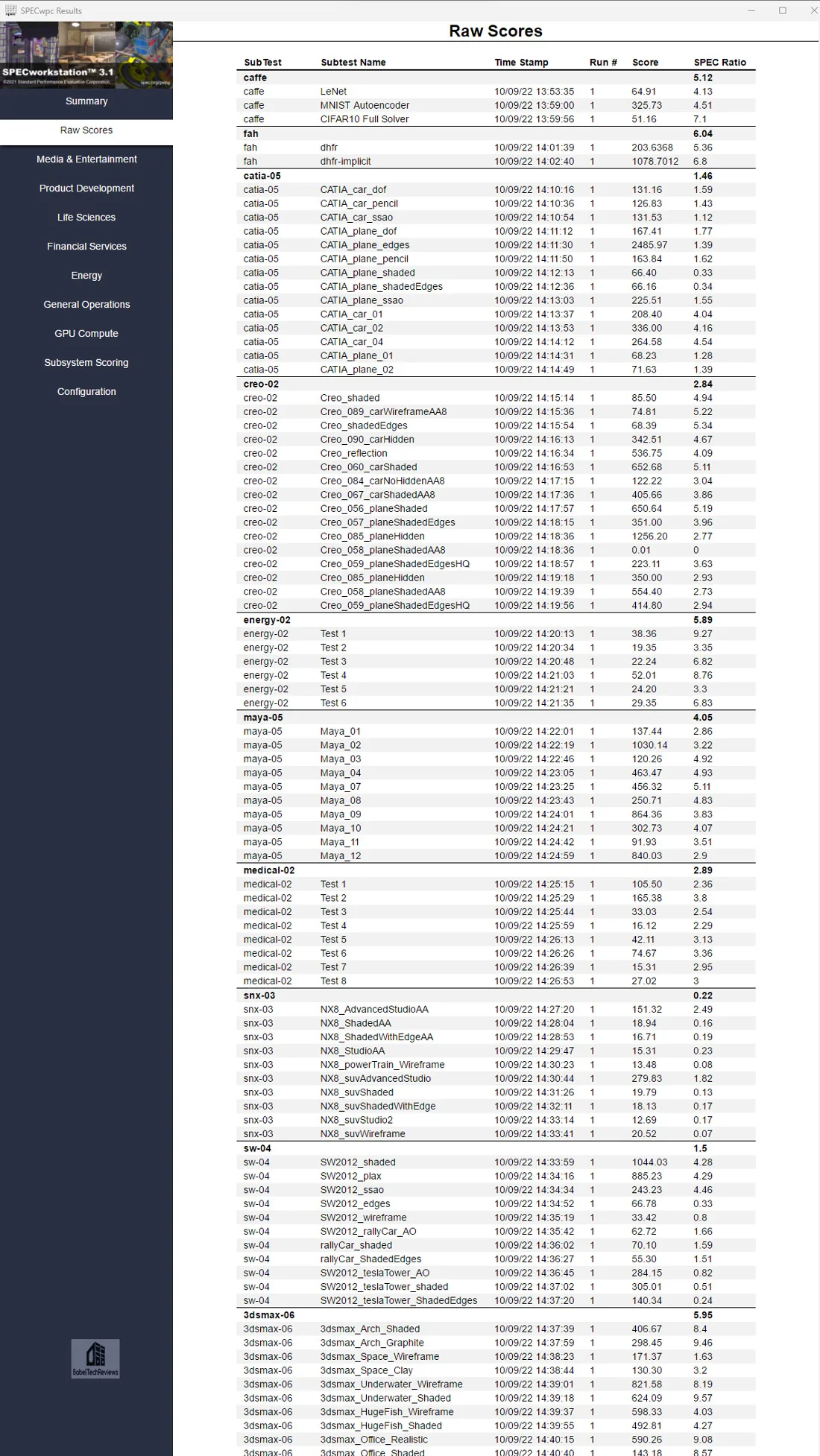

Finally, here are our SPECworkstation 3.1 raw scores for the RTX 4090:

Below are the SPECworkstation 3.1 RTX 4090 results summarized in a chart along with the two competing cards, the RTX 3090, and the RTX 6900 XT. Higher is better since we are comparing scores.
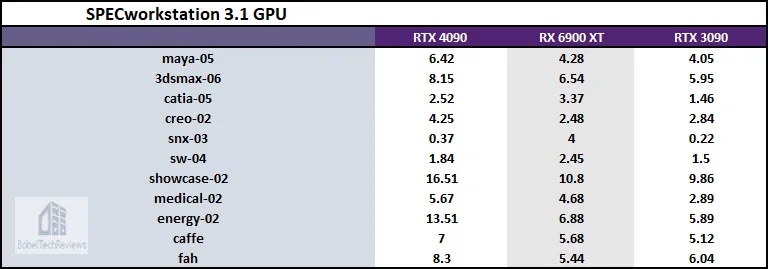
The RTX 4090 is not a workstation card, yet it uses brute force to win most of the benches against the other two cards. The Radeon scores unbelievably high in snx-03, however, and we have no explanation for this result.
Finally, we benchmark using SPECviewperfect GPU benches.
SPECviewperf 2020 GPU Benches
The SPEC Graphics Performance Characterization Group (SPECgpc) has released a 2020-22 version of its SPECviewperf benchmark that features updated viewsets, new models, support for up to 4K display resolutions, and improved set-up and results management. We use the highest available 3800×2120 display resolution for highend cards.
Here are SPECviewperf 2020 GPU RTX 4090 benchmarks summarized in a chart together with our two competing cards.

Although we see different architectures with different strengths and weaknesses, the RTX 4090 is a beast in these SPEC benchmarks.
The RTX 4090 doesn’t offer any certifications for professional applications and it is not expected. It is likely that in workstation specific benchmarks, there will be cases where a Quadro board will outperform the RTX 4090 GeForce card. This is why professionals pay much more for Quadro than for any GeForce with otherwise equivalent raw performance.
After seeing the totality of the benches, many creative users will probably upgrade their existing systems with a new RTX 4090 series card based on the performance increases and the associated increases in productivity that they require. The question to buy the RTX 4090 or the RTX 3090 should be based on the workflow and requirements of each user as well as budget. Time is money to a professional depending on how these apps are used. Hopefully the benchmarks that we ran may help you decide.
Let’s head to our conclusion.
Final Thoughts
This has been a very enjoyable exploration evaluating the new Ada Lovelace RTX 4090 FE versus the RTX 3090 FE and Gigabyte RTX 6900 XT Gaming OC. The RTX 4090 performed brilliantly performance-wise. It totally blows away its other competitors as it is much faster. The RTX 4090 at $1599 is the upgrade from the $1499 RTX 3090 since the RTX 4090 gives at least a 160% (1.6X) improvement over its baseline performance. If a gaming enthusiast wants the very fastest card – just as the RTX 3090 was for the past two years (until the up to 10% faster RTX 3090 Ti was released), and doesn’t mind the $100 price increase – then the RTX 4090 is the only choice for intensive gaming and high resolution VR headsets.
The RTX 4090 is the flagship gaming card that can also run intensive creative apps very well, especially by virtue of its huge 24GB framebuffer. But it is still not a Quadro. These cards cost a lot more and are optimized specifically for workstations and also for professional and creative apps.
For RTX 3090 gamers who paid $1499 and who have disposable cash for their hobby, the RTX 4090 Founders Edition which costs $1599 is the card to maximize their upgrade. And for high-end gamers who also use creative apps, this card may become a very good value. Hobbies are very expensive to maintain, and the expense of PC gaming pales in comparison to what golfers, skiers, audiophiles, and many other hobbyists pay for their entertainment.
We cannot call the $1600 RTX 4090 a “good value” generally for gamers as it is a halo card although it provides more than 1.6X the performance of a RTX 3090. Of course, a RTX 3090 can be currently found at many etailers for under $1000 and a RTX 6900 XT for less than $700. Value is in the eye of the beholder, and the RTX 4090 delivers on its raw performance promises.
In addition, DLSS 3 brings a great future value to the new 4000 series as it has already received support from many of the world’s leading game developers, with more than 35 games and applications announcing support including game engines, including Unity, Unreal, and Frostbite Engine. If a game already uses DLSS 2 Super Resolution, upgrading to DLSS 3 is a relatively simple process that will make both Super Resolution and Frame Generation available. DLSS 3 leverages the same integration points as DLSS 2 (color buffer, depth buffer, engine motion vectors, and output buffers) and Nvidia Reflex, making upgrades from these existing SDKs easy for devs using the DLSS 3 Streamline plugin.
We will follow up with a DLSS 3 review since what we have experienced so far is extremely promising especially for upcoming less powerful Ada Lovelace cards.
Conclusion
We are very impressed with the RTX 4090 raw performance after spending more than 100 hours testing it over the past few days. It offers exceptional performance at Ultra 4K and and it even supports smooth playable gaming at 4K/120Hz using Quality DLSS and may be used for 8K gaming. It currently stands alone as the fastest video card in the world. 
The Founders Edition of the RTX 4090 is well-built, solid, good-looking, and it stays cool and quiet even when overclocked – the card does not get hot like the RTX 3090 and it is much quieter under load. The RTX 4090 Founders Edition offers a big performance improvement over any previous Founders Editions in every metric.
Pros
- The RTX 4090 is the fastest video card in the world
- The RTX 4090 at $100 more than the RTX 3090 launched at is at least a 1.6X+ jump in raw performance
- The RTX 4090 offers an overall 160% to 180% improvement over the RTX 3090’s baseline performance (at 100%) depending on the resolution and individual game, and in several examples it offers nearly a 200% improvement!
- 24GB of fast vRAM and a fast core allow for 4K/120Hz gaming and it’s also very useful for intensive creative apps
- Ray tracing is a game changer in every way and DLSS 2 is pure magic. DLSS 3 looks to be even more of a game changer
- Ada Lovelace improves over Ampere with AI/deep learning and ray tracing to improve visuals while also increasing performance with DLSS 2 and especially with DLSS 3
- The RTX 4090 Founders Edition design cooling is quiet and efficient; the GPU in a well-ventilated case stays much cooler and quieter than the RTX 3090
- The industrial design is eye-catching and it is solidly built
Con
- Price. At $1600, the RTX 4090 is not a good value for gaming except as a multi-purpose halo card or for bragging rights
The Verdict:
 If you are a gamer who also uses creative apps where saving time is important, you may do yourself a favor by upgrading to a RTX 4090. For high-end gamers with disposable income, the RTX 4090 is a true 4K/120Hz video card for most modern games and it offers the highest performance as an upgrade from a RTX 3090 delivering from 160% to nearly 200% improvement in raw performance power.
If you are a gamer who also uses creative apps where saving time is important, you may do yourself a favor by upgrading to a RTX 4090. For high-end gamers with disposable income, the RTX 4090 is a true 4K/120Hz video card for most modern games and it offers the highest performance as an upgrade from a RTX 3090 delivering from 160% to nearly 200% improvement in raw performance power.
Stay tuned, there is a lot more on the way from BTR. Next up, we will more extensively test the RTX 4090, RTX 3080, and RX 6900 XT in VR using the Vive Pro 2 and Reverb G2 with an ETA of early next week. We also plan to follow up with an RTX 4090 overclocking review and a DLSS 3 deep dive. Stay tuned to BTR!
Happy Gaming!
UPDATE: I shared my data with John Peddie Research and they posted their own take on the RTX 4090 focusing on averages and easy-to-read charts including their famous Pmark overall comparison.
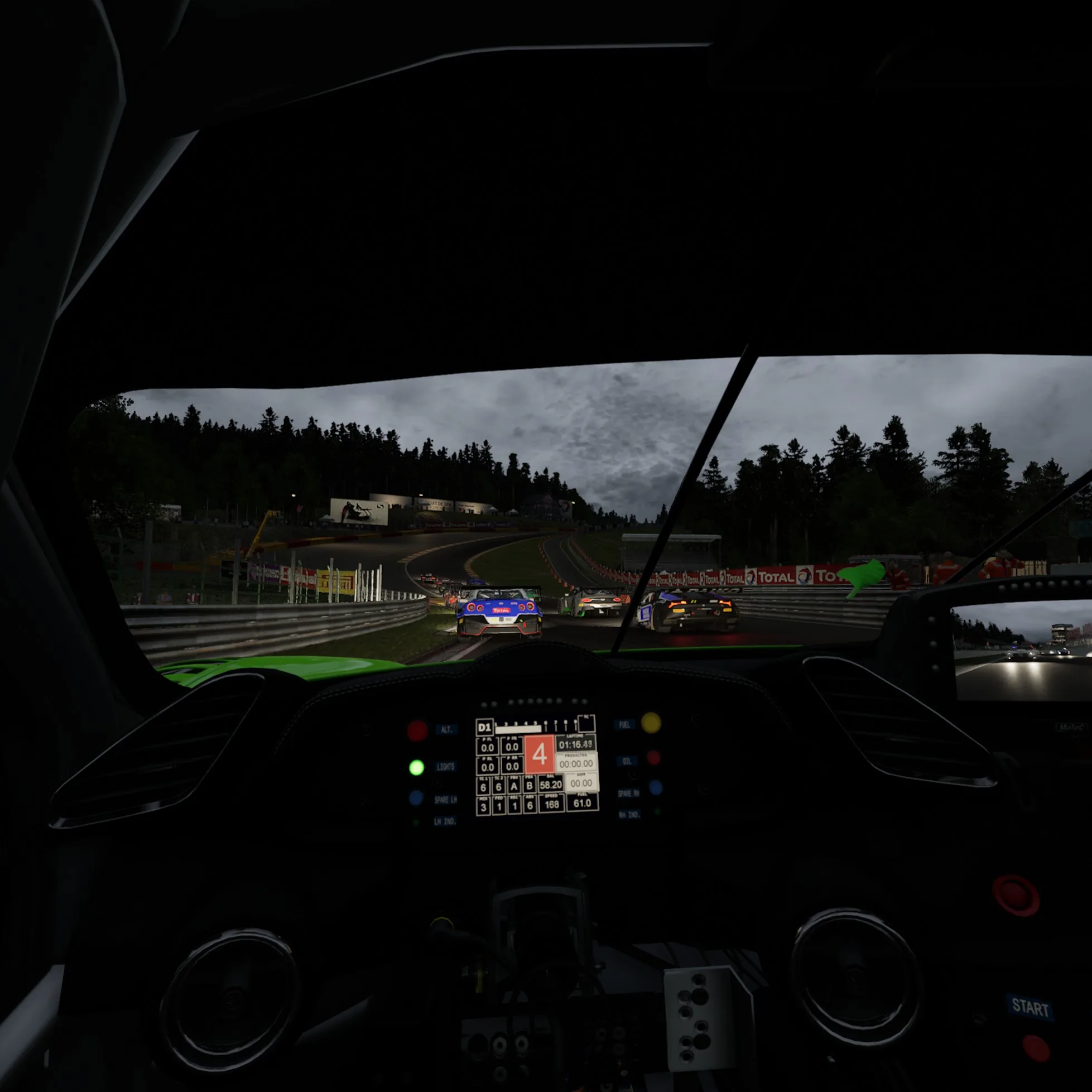

Comments are closed.